#also the second image reads ‘the trilogy’
Explore tagged Tumblr posts
Text


@sneakydraws and I still haven’t figured out the details yet, but tldr Bajie who’s been a disaster of a lawyer at the time acted as a prosecutor in a case against someone Xuanzang decided to help. Chang e was the defence attorney and there was a whole court battle between the two. Bajie was hired by Xuanzang after he was defeated.
He’s very talented in navigating the law but he’s just kind of trash like everyone else in this au- good for him : )
#journey to the west the demons strike back#the demons strike back#17jttw#17jttw modern au#suntang#illegally bound au#zhu bajie#sun wukong#tang sanzang#it’s also funny because Xuanzang is not a lawyer he is only a consultant that’s called to the stands#but he’s so self absorbed he steals the spotlight anyways#also the second image reads ‘the trilogy’#he’s low-key my fav character we developed like frrrr
126 notes
·
View notes
Text
ELTINGVILLE CLUB INSERT MOMENT !!
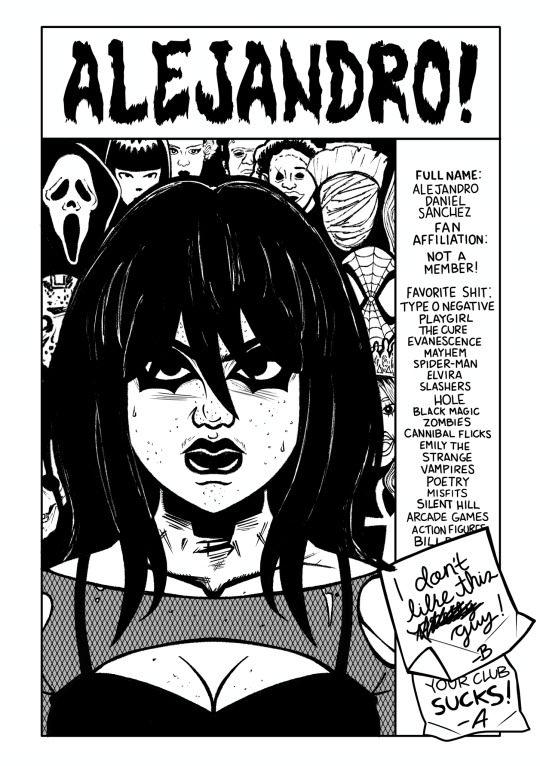

hi, presenting my silly fella here too, his name is alejandro and he’s a goth NOT affiliated with the eltingville club, he has his own club. it’s a little extensive to resume his whole backstory so I’ll concentrate on how his relationship began with bill, who he met one day he was roller skating at the street and the boys were rolling their dices in the middle of the road, this caused alejandro to trip over and provoke for their dices to end up in the sewer; of course bill started insulting him along with the group, but he was the louder one and who caught alejandro’s attention, fighting back. the second time a new spiderman issue came out, the planet of the symbiotes, ale as a spiderman fan saved money to buy it, he entered joe’s store and noticed the last copy of the issue was prettily positioned on the shelf, once examining it closely he felt a hand on his shoulder asking him harshy to not buy it since he wanted it to himself, guess who it was? obviously, william alan dickey being an annoying little bitch, anyways alejandro ends up getting it and bill gets super pissy about it.
finally, their third encounter was at a blockbuster, bill wanted to rent the star wars trilogy, browsing the sci-fi shelf he looked up and noticed alejandro right in front of him just a few centimeters away, his face focused on the cover of ‘wes craven’s new nightmare’ (he loves horror movies), to resume bill starts walking behind him yelling at him that he stole his precious comic but then notices the tape on his hand, to which his attention picks up and starts getting interested in alejandro; a few weeks later their situationship starts and both suffer for the other cuz they’re stupid.
thanks to anyone reads this, if someone does !
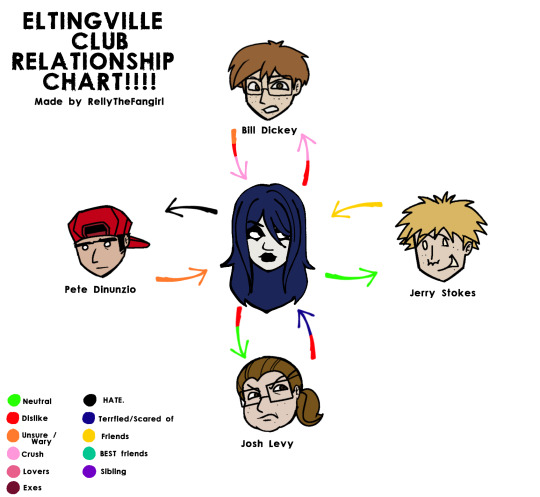
silly thing also, creds in the image :-)
if you wanna know more about my silly creature just ask me in my inbox I suppose !
#the eltingville club#welcome to eltingville#tec#self insert#self ship#bill dickey#this is embarrassing#yes I am ashamed of self shipping#yes I will keep doing it#goth#Spotify
45 notes
·
View notes
Text

Hi! Thanks for your interest in the Superfam big bang - we’re so excited to have you here!
While we hammer out details and taglists, this blog is a work in progress; pages will be updated as we get things sorted, and we’ll have it up and running by the end of the year!
What’s this all about?
There’s no big bang event for the Superfam!!!!!! and unfortunately both of us love these Kryptonians (and all the humans they’ve surrounded themselves with) so we had to. If you’re here you definitely get it 🤭
What’s the word count / art minimum?
🌻 at least 20k for Authors. 🌻 at least 1 x full colour art piece for Artists 🌻 at least 1 x full gifset (6 gifs) or 3 x images for Manip creators 🌻 We do NOT accept AI.
When are we doing posting?
Check out our schedule! [mobile link] Sign ups open April, 2025, and fics will be completed by January 2026.
Can I use a fic I’ve already posted / write a sequel to a fic I’ve already posted?
We are not accepting fics that have already been posted, unless the part you have posted is 500 words or less. For example, if you wrote a short headcanon post on Kenan and how he adjusts to interacting with Lois, and then want to write further on that concept via an interdimensional space adventure, that would be 100% allowed. However if you had written a 600+ word drabble on Kara being a horse girl, or a “what if Kryptonians had wings” AU, you would not be able to use that for this bang. The base concept of what we’re trying to do by limiting fics that have already been posted is to ensure that the artist & author match ups are random, and not based off someone recognising someone else’s work in an effort to get that partner. We want this to be a fun passion project, and a way to make new Superfam friends! This connects to sequels too: any direct sequel (ie. a fic that would require you to read the first one in order to understand the second) would not be allowed, but we would accept a spin-off or inspired-by fic. Think the Hobbit vs. The Lord of the Rings trilogy, or how all the Narnia books are in the same interconnected world, but are not direct sequels. Please just reach out to the mods if you want to use something that’s already been posted/want to make a sequel or spin-off to a different fic, and we can discuss it from there.
Are there any specific characters that are off-limits?
Think of the Bang like the fics / art are all issues from a Supers comic run: They can have guest stars, but it’s their show. While we won’t say characters are “off-limits”, we are making the limitation that if you are writing a fic that may feature another hero or team - ie. a Superbat or YJ fic - you either: 🌻 feature the superfam member’s POV at least 50% of the time or 🌻 the fic must be directly exploring the superfam member and their story and character
How are you running the posting period?
As the event doesn’t start until next year, we are going to adjust some things depending on the contributors we get and how the event runs, but! The major way posting will run is as such: When fics are complete, we’re going to check in with everyone via discord and see which of 2 preferences they have: If you want to participate in posting chapter by chapter, we will be enforcing a finalisation date - ie. that the fic must be posted in entirety by a certain day. There will be freedom to decide what the schedule is and how you divide chapters, but the “slow release” will still be a short period (ie. 1-2 weeks, depending on fic length). You would also need to discuss with your artist when they would post their art, and work together to decide the best time to link your pieces. The mods will also only be reblogging your fic to @/superfambigbang on the first chapter, and then when it is posted in entirety. While we will not edit the fic, if you elect for option 2, the mods will most likely contact you so we can check your project, as we understand a “slow release” is a non-standard way of running a bang project and want to ensure it goes smoothly.
The other way is, of course, the standard way a bang is posted; all at once / entirely posted on one day. Dates will be assigned while keeping in mind author/artist preference, however we will be trying to ensure space between each contributor so that the fics all get space to stand out ❤️
Can I sign up to beta?
Thank you so much for the interest! We’re going to see who within the event would like to beta first, and then potentially open a beta check in Jan 2026, when fics are complete.
Is NSFW / dark fic allowed?
If you write a NSFW or dark fic that’s completely fine, but be aware that the event is for all ages. If you write a fic that discusses sensitive or NSFW topics, we will request that any discussion regarding your fic be kept in the appropriate area on discord. If you violate this rule accidentally (ie. forget what chat you are in and post an implication of NSFW), you will be given one warning before you will be removed from the event. If you violate this in an extreme manner (ie. any nudity, explicit sexual references, explicit violence etc., in any area that is not the NSFW channels), you will be kicked from the discord and blocked from participating in any feature events.
Can we write for xovers?
As long as it features the Superfam you can write about whatever! Want Jon to end up playing Homestuck? Want Kon or Kenan to end up hanging with the Avengers? Want the Superfam to meet the cast of Invincible? Go for it! As per the other guidelines mentioned above, our one major rule is that it must be featuring the Superfam - this is a Superfam-themed event, after all!
Are we allowed to write more than one fic?
Keeping in mind that the minimum word count is 20k and we want to ensure that as many projects are completed as possible + we want to ensure match-ups work out, at this point in time writing a second will depend on if your first is finished, as well as how many artists sign up.
At the current point in time (and because this is the first time we've run a proper big bang together!) writing two fics will not be allowed unless one of them is complete or semi-complete prior to artist match ups, and the other has reached the minimum word count check-in for the artist sign ups.
Please reach out to the mods via [email protected] if you want to discuss this further.
Where’s the discord link?
If you sign up, the discord link will be on the last page of the sign up form! However if you did not receive it, please feel free to reach out to [email protected] and we’ll see what’s gone wrong.
We’ll also be running movie nights, sprints, and other games during the big bang period, so we hope to see you there! 💕
I just looked at the schedule - what is the November mini wrimo?
To encourage people to write and to make some fun interactive challenges in the event (and with NaNoWriMo’s unfortunate decision to be dumbasses), the mods thought it would be fun to set November as a mini writing challenge! If you sign up for the bang, you do not have to complete in the mini wrimo if you want to, but the option is there. The gist is, much like nanowrimo, a challenge to write a little bit every day - with challenges, sprints, and a badge at the end.
We’ll be aiming for 10k (350 words/day), so if you do sign up, that means by the end of November (and keeping in line with the other check-ins), authors will have 20k for the event, and will have plenty of time to edit and maybe start a new project! ♥
Who runs the event?
thanks for asking! that’d be @authenticaussie and @cer-rata. Nice to meet y'all! Please send us any questions via this blog or our official twitter, and we’ll get back to when you can. We hope you enjoy the event! See you soon!
If your question hasn’t been answered above, check our #faq tag or please send us an ask!
#organisation#faq#dc comics#dc events#clark kent#superman#lois lane#kon el#kara#kara zor el#john henry irons#natasha irons#othul ra#osul ra#kenan kong#supergirl#superboy#jon kent#Jonathan Kent#superfam#martha kent#ma and pa kent#red son#starchild#superfam big bang#writblr#john irons#nat irons#krypton#jimmy olsen
27 notes
·
View notes
Text
The Soul Still Burns: Analysis of the Lords of Cinder (DS3)
What follows is a short essay on the Lords of Cinder from Dark Souls 3, exploring their symbolism on spiritual and metatextual levels. After that is a related reading of Slave Knight Gael, the final adversary of the Dark Souls trilogy.
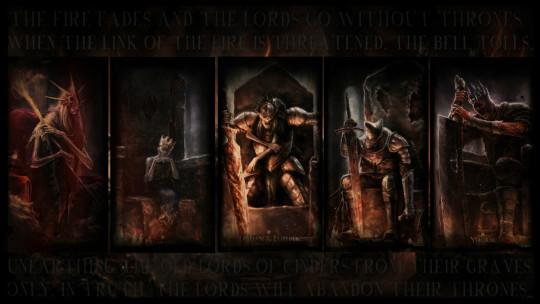
The Lords of Cinder are in many ways the primary adversaries of Dark Souls 3. This title they share, “Lord of Cinder,” refers to a personage who has rekindled the first flame, keeping the cycle of light and dark going.
Cinder is a substance which continues to burn without the presence of fire but does not reduce to ash. So euphemistically, it seems that the Lords are somehow stuck in their process of purification, and the game suggests that the world is stuck along with them; this is why it is the Ashen One’s task to “set them upon their thrones”—to hurry them along and thus allow the world to follow its natural decline. As individual characters, each of these Lords represents a different attitude that complicates and prolongs the cycle.
Through these stubborn Lords the game is commenting on at least two things. On the metaphysical level, it reflects the Buddhist idea that certain attitudes keep people reincarnating over and over again, unable to extricate themselves from the material world of suffering (samsara). While on the metatextual level, the game is suggesting that certain attitudes keep players coming back to Dark Souls again and again, starting new games, making new builds and revisiting old files.
The idea there on the metaphysical side finds an easy analogy in Buddhist doctrine: the “three poisons,” the three root causes of suffering. These are hatred, greed, and delusion. What’s interesting is that these essential vices also fit pretty easily onto the different types of players that are being caricatured by the Lords. We’ll break these correspondences down in a second.
But First: Why Do They Correspond? So we have these sets of three. Three lords, three poisons in Buddhism, three types of Souls players. How convenient. When we analyze art, we sometimes ask, “Huh, is this structure really there, or am I projecting it into the material?” And if the structure is really there, baked into the work, that doesn’t mean that it’s due to developer intention. Archetypal forms sometimes show up in work via an unconscious influence, be it due to the cultural milieu, personal psychology, or some a priori biological disposition of the human being.
And the thing about Dark Souls is that it’s an unusually honest piece of art, in that its creative team allows their own free associations and intuitions to show up in the work without too much self-censorship or questioning. They make space for a mystery to show up on its own terms, and in leaving its riddles unanswered, there is more space for discovery by the people who play it.
It should also be said that cultural ideas persist for a reason. Beneath the ethics and ideology of the people who originally named the Buddhist “three poisons,” there may be something timeless, something perennially descriptive of human nature. If that is the case, then it would make sense for this same triplicity to unfurl itself in other cultural products. So for one reason or another, these three poisons, these addictions, show up diegetically in the characters and are also expressed in player psychology.
I say all this just because sometimes I feel very aware of the disconnect between much of Souls lore discourse and the broader field of mythological study. Since we are gamers first, there may be this tendency to want to “solve” the lore, but that’s not what we’re doing here. Myth functions because it elaborates our experience of the world through affective resonance; it attaches images and characters and stories which help us anchor our own prelinguistic impressions of the world, cultivating our sensitivity there.
Anyway, let’s look at these Lords.
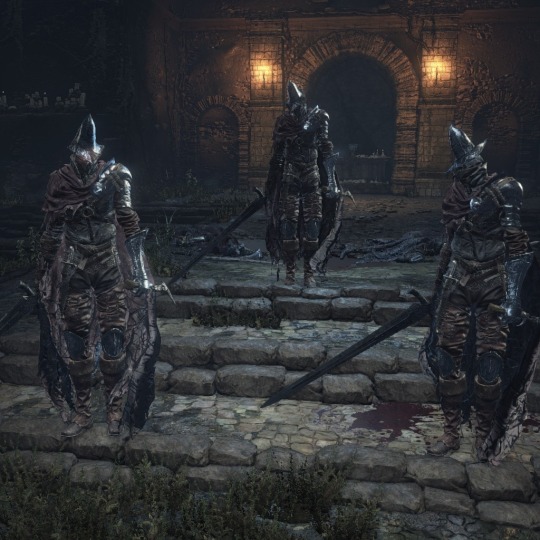
Abyss Watchers Poison: Hatred The lore of the Abyss Watchers is pretty clear: they have an obsessive fixation on the abyss, and are ready to raze an entire town if they suspect abyssal encroachment. This obsession has literally possessed them, as they are now “abyss touched.” Gaze too much into the abyss, etc. They carry such strong contempt for the disavowed object that they don’t care what comes between it and their sword. This is clearly demonstrated by the fact that they are a brotherhood yet are unhesitatingly slaughtering themselves again and again. Hatred has made them blind, and has also caused them to resign their individuality (they are identical, mere instruments of a transpersonal grudge). They cannot die, their hatred keeps them locked in combat.
Type of Player: competitive | Interest: combat The Abyss Watchers are a representation of PvP addicts. They have no powers other than tenacity; they perform the same combos repeatedly. When you are really gripped by a PvP binge in Souls, you often end up doing the same thing again and again. The fight takes place in a mausoleum, on top of many chambers filled with human remains. The fact that this boss fight is instructional about combat, specifically about looking for tells (a cloud of dust always signifies the end of their combos) might be another clue. There is no limit to how good you get at Souls PvP; every foe is an opportunity to improve timing and strategy. You can just keep stacking anonymous bodies under yourself.
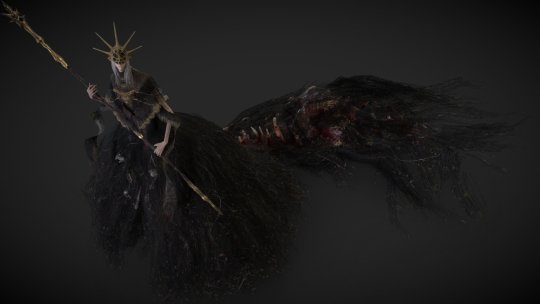
Aldrich Poison: Greed Aldrich invokes the concept of supremacy many times: he is in the supreme area from Dark Souls 1; in the supreme boss room of that area; he wears as a crown the former supreme lord of that area. This is because he devours lords; he tries to take prestige upon himself through acquisition and incorporation—greed.
Type of Player: completionist | Interest: content Aldrich is a commentary on completionist players. He is someone who “plays the game to death”, acquiring every object, reaching every achievement, devouring the soul of the game through taking everything into himself. He becomes bloated by consuming as much of the game’s content as possible. The old God whose likeness he has adopted is Gwyndolin, who was, in narrative terms, the one pulling the strings in the land of the Gods. And in gameplay terms, he is a secret boss. So on both counts we have someone who is elusive, and exists more or less at the boundary of the gameworld. When a player tries to see every last little morsel of a game, they become somewhat like Gwyndolin, a manipulator of a virtual world. If you know too much about a game, you have the risk of being less immmersed.
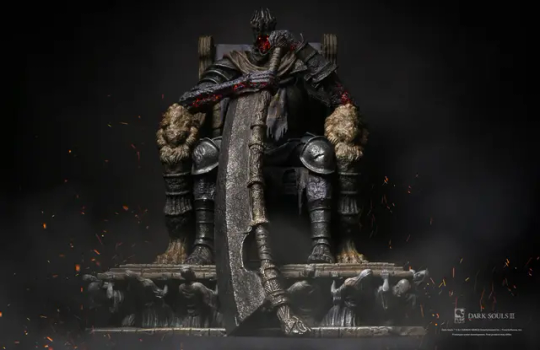
Yhorm Posion: Delusion In Buddhism, the poison of delusion secretly underlies the other two poisons, as the impulse toward hatred and greed are ultimately born of some false view about reality. This is akin to how the profaned capital sits below the rest of the kingdoms. To beat Yhorm you essentially have to “play pretend” with him, picking up a fake super-weapon, or fighting alongside Siegward, a knight who appears to be somewhat deluded about the state of the world, enthralled in the same fantasy as Yhorm himself.
Type of Player: lore researcher | Interest: meaning The profaned capital is full of statues—fixed images of myth; and empty goblets—treasures with no utility. Not to mention the area with the swamp which is full of symbolic imagery, but serves no narrative or mechanical purpose. The entire profaned capital challenges us to make sense of it; it is the ultimate temptation of lorekeepers in DS3. It throws at us a disproportionate amount of reference to DS2, which is famous among Souls players as the least thematically sensible Souls game. The Greatshield of Glory is found right outside Yhorm’s room, in a conspicuous room full of treasure, and yet it is a very impractical shield and offers very little lore value. If a lore-minded player picks it up, it directs them to a legendary personage from the War of Giants, which raises far more questions than it answers. The same is true of much of this area—the Eleanora, the Monstrosities, the Profaned Flame itself—they are all there to get you to speculate. These are the players who come to Souls games again and again, trying to find the “ultimate meaning.” They seek the grail, claim to find it, and then chuck in a pile with the others.
Yhorm's story also imitates the primordial Artorias myth: forsaking his shield in preservation of something more valuable. Other than that Yhorm is largely a cipher when it comes to biography, with a void for a face, which itself epitomizes what must remain at the center of mythology and storytelling: mystery.
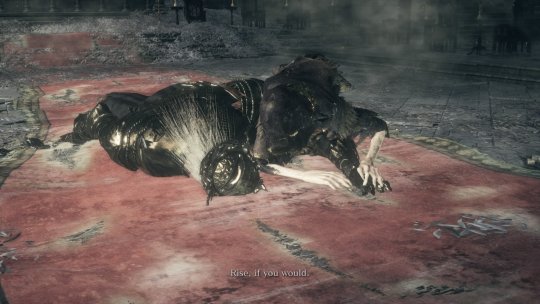
Sit Down and Seek Guidance So we have the three reasons that people become fixated on Souls: the combat, the achievements, and the mystery. But there is a fourth lord of cinder boss, who is conceptually apart from these three: the Lothric Twins. They represent yet another kind of person who must keep playing Dark Souls: the developers. Lothric is striving to produce “a worthy heir,” a proper sequel to Dark Souls 1. The Princes are bound to their chamber as the developers are bound to their project, as that is their curse—“but you may rest here too, if you like.” In this context we can see their duality as the dual nature of having to work on the game and also play it to death. The privilege and the loftiness of the promise of a great piece of art (Lothric), and also having to go back "into the trenches" of the work itself (Lorian). Notably, neither of them can walk, they just teleport around. They are stuck at work, trying to bring the new world into being. Also I can’t go this whole essay without mentioning the obvious: that the Ashen One is bringing Lords to their thrones, and we players and developers have to assume our little chairs and couches when we access this world.
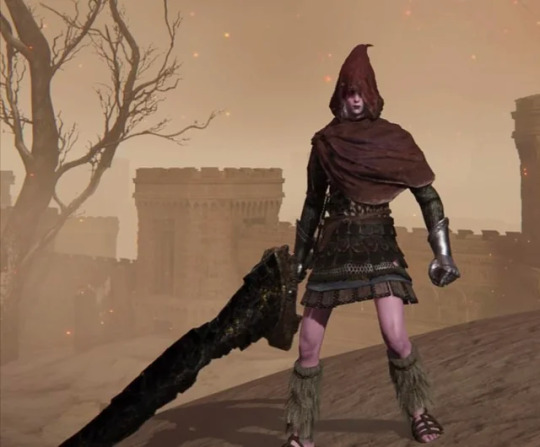
Playing Beyond the Point of Pleasure Of course the most extreme example of someone stubbornly remaining in the world no matter what is Slave Knight Gael. He is looking for pigment, which seems to be a euphemism for the substance of humanity (the Dark Soul). He wants to give it to the painter, the world-creator, so that a new world can be made. He is willing to indulge in a wasteland of abject violence for as long as it takes in order to renew something. Ironic that he is probably only prolonging the current world in his obsessive drive to recycle it faster.
Let’s examine the relationship between the figure of the painter and her relationship to Gael. That she is a spiritual entity is obvious: we never see her touch the ground, she is always in an upper room and lifted on a piece of furniture. Among other things, she is a clear metaphor for life springing eternally. A creative child who continues to paint despite kidnapping and imprisonment. She is the heart of the painted world, itself a place that symbolizes the idea of the representation of reality.
I want to make sure this is clear, because it is a bit of a kaleidoscope to consider. Any subject in Dark Souls stands for many things, but something that the painted world specifically represents is the very concept of representation. So of course the places in our imaginations are painted worlds, but so is this physical world of appearance, the maya of mundane reality. Not to mention that a work of art is a painted world, and the game we’re discussing is a painted world. When a work of art is able to recreate itself in itself, we can see this funny effect of mirrors reflecting mirrors infinitely. This results in seemingly inexhaustible symbolic content—there is so much potential to find meaning and create connections. Because Moby Dick represents a work of literature; the Tempest represents a play; Twin Peaks represents a TV show, these works can offer extensive insights not only into their medium but into the nature of reality. In these and other examples, the representation of the medium within the work may or may not be a single subject, but since Dark Souls is formally a game about levels and level design, the painted world is the heart of its self-reflexivity. The painted world can be pointed to as the summary of this fractal device. And the personification of that device, its ambassador to the player, is the painter.
The miracle or divine child is also an archetype familiar to us from Lothric, in their struggle to produce the “worthy heir.” Reality seeks salvation through the appearance of grace. They want it in a clear, incontestable form—to be able to point at it and say, "thank goodness we went through all that, because look, now here is the meaning, here is that which validates all that came before." In the world of Dark Souls 3 the religion of the masses is the Lothric stuff; meanwhile knowledge of the painted world is much more obscure. Lothric’s religion is obviously regulated and hierarchical, while Gael’s devotion to the painter is highly personal and private: he carries around a scrap of painting; he prostrates to a hidden idol in a small chapel; he considers the painter his family. He is emotionally close to the object of his worship.
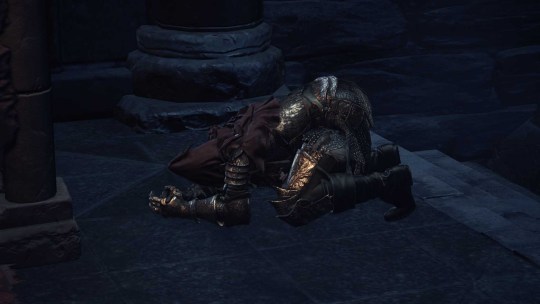
But whether it’s Lothric or Ariandel, they are anticipating the divine child to redeem the world. As an archetype, the child ultimately represents surprise. The possibility of being delighted by life in its creative novelty. The child as an archetype appears in our own behavior when we do something without any sort of contrivance or mental interference, doing something in the world which doesn’t seem to have come from who we conceive ourselves to be. This is miraculous. Such an action enchants the world, and there is no explaining it, even if it may weave all kinds of stories around itself, retroactively framing things that have led up to it as portents or promises. (Though not exclusive to him, this trait is well-known in characterizations of Christ, and DS3 is clearly indebted to Christian iconography, so do with that what you will). Regardless of the specific cultural invocation, the divine child is a personification of something that happens within the human spirit. TFW you are renewed by a fresh and spontaneous engagement with life.
The grace of the miraculous often comes to us through play. Play is more of an attitude than an activity; the feeling of play may come to us through making a painting, or chatting with a friend, or moving around in a video game. We can play video games idly, competitively, experimentally, creatively, studiously, whatever, the feeling of “play” can show up regardless. We can sit there playing a certain game from a certain motivation, and feel totally rote and joyless, and question, “Why am I doing this?” Or we might sit there and play the same game with the same motivation, feeling totally lit up by it, its purpose to us obvious and self-validating. We are not even questioning why we are doing it, we are enjoying life.
This is really the ground that the miraculous tends to land on. Grace, meaning, and an immanent love of life are more likely to show up when we are in flow and not exercising our capacity for self-assessment. But like everything in life, we mistake the images and objects around us for the feeling of grace. Any given object might only be the catalyst once; it’s not about the object. This is extremely easy to see in cases of acute nostalgia; adults chase enchantment through collecting Zelda memorabilia or going to Disneyland, in pursuit of what kindled their spirit as a child. It was never really the game or the character that was doing it, it was what they were able to access within themselves.
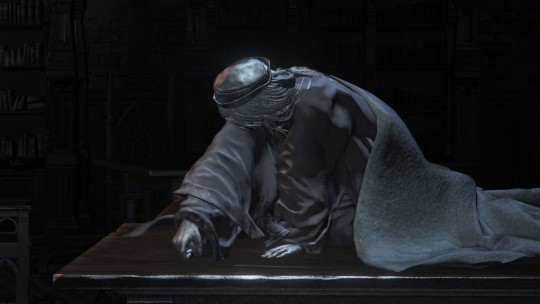
So anyway Gael has yet to realize this. He thinks the Dark Soul is out there in something else. That it will be yielded as a drop if he just kills the right enemy, or 10,000 enemies, or goes to the right place at the right time. You can see that this is something of a synthesis of all the other Buddhist defilements: there are elements of completionism/greed, violence/hatred, mysticism/delusion. There is even the suggestion of the developer of these games again, in that Gael is a “slave,” forced into participation in the world to assist some creative apotheosis. (Isn’t it funny that his weapon is a worn-down executioner’s sword?—whether the person coding or the person playing, we are all “executing” command after command). The thing that really keeps him on the wheel is something beyond any of the player types and their vices; it is almost some sort of pure, amoral automatism, a churning drive that on one side resembles wanton nihilism, and on another side single-minded piousness. Is one disguised as the other, or has Gael somehow stepped beyond this binary? Yet another dichotomy in Dark Souls that begs to be reconciled, but whose tension creates the opportunity to participate creatively in its expansive mythology. When things are held apart we can move between them.
To really understand Gael, we have to contend with the question of a person’s relationship to their own soul, since that relationship is so plainly suggested by Gael and the painter. (This question, by the way, is much elaborated in Elden Ring, with its repeated foregrounding of the image of the maiden or “consort”). If we were to see Gael and the painter as partitions within one person--whether she is his soul, or his inner life, or his better nature, whatever—then in any case Gael is the side which goes out into the world and experiences it. He is the creative extension into the world as its active participant and realizer. Yet he is clothed as the warrior, the executioner. While the one who is dressed as the artist, the painter, just stays in her room and imagines the world—but this is where the magic of creation is really felt. We involve ourselves in life, or in a game, but we are only really changed and renewed when that exterior experience is “brought home” into the inner life. We do something “in the game,” but the act of “painting,” in renewing the world through our creative interpretation, is a decidedly interior experience.
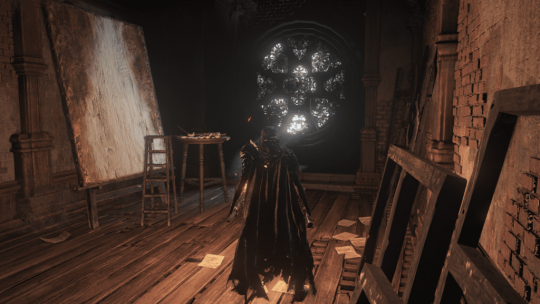
#dark souls#dark souls 3#lords of cinder#game entrainment#dark souls analysis#dark souls lore#ariandel#slave knight gael#the painted world
86 notes
·
View notes
Text



recently realized i never officially posted the third peice in the t4t house party trilogy. You may have seen some of these, but they’re kinda meant as a set…. i may make more but. these are the big three.
[ID: Three images. All are traditional illustrations on paper with vibrant color.
The first is in watercolor, gouache and ink. It is of a crowded party with overlapping figures. The composition is chaotic and colorful. Notably, a person with choppy green hair and a yellow cane stands in the center. Around them, a couple embraces, a person lies with their legs up in the air, a woman sits on a chair, a pile of cups and drinks towers over the partygoers, and another person reclines while sipping from a cup. the figures and background overlap and stack upon eachother.
the second is a traditional watercolor and ink painting. A crowded house party full of trans people takes place. In the foreground, a pair of legs wearing brightly colored pants lean on a sofa while someone unbuttons their jeans. A woman stands in a fur coat with a scarf in her hand. Two men kiss passionatly. Some people chat in the background while one person stands alone and confused. The peice uses neon and neutral tones, the whole peice warm in color.
The third is A colored pencil drawing done on green toned paper. The image has a select color pallete, with the main tones in the image being pink, magenta, crimson, greyish green, a very pale light green, and a deep viridian. Six characters interact at a party. In closest veiw, a face of a smiling person with butterfly locs and glasses takes up a large part of the bottom corner of the image. Moving back, two people, a pink haired pale person, and a south asian man with forearm crutches lounge on a couch. The man seems to be the center of the page, and is smiling, others around him appearing to be laughing at something he said. He has a star shaped symbol covering one of his eyes. Behind the couch, another man with shaggy white hair and a phalloplasty scar stands frozen, holding a drink. He is looking at the lounging man, and he also has a star covering one of his eyes. Behind them, two women, a hijabi wearing a shirt that reads ‘butch dyke’ and a black woman wearing pink overalls talk. All of the people stand in an apartment, the walls covered in paintings as well as a large fireplace.
End ID.]
#artists on tumblr#trans artists#queer artists#traditional art#watercolor#ink#gouache#colored pencil
274 notes
·
View notes
Note
I've been reading your blogs regarding s2's story mode (which I'm coincidentally also playing through rn lol) and I love the vent-song interpretation for Callie!! The other posts have honestly been an eye opener for me lmao
I personally always saw it as turquoise october making their own little tributes to her (especially girl from Inkopolis) using samples from her older songs (tho it's still music from the life callie was trying to run away from, so I'm not confident in my theory :')), like they're appreciating and celebrating her
(Generally I fell that the squid sisters are PAINFULLY underutilized in the story modes they're in, it hurts me.)
AYEEE! I'm glad that I've been such an eye opener for you and I hope that you enjoy Splatoon 2's hero mode a lot more because of it! That's my goal man, to make people have deeper appreciations of stuff in Splatoon because there's a lot of stuff that I think is really really cool and interesting.
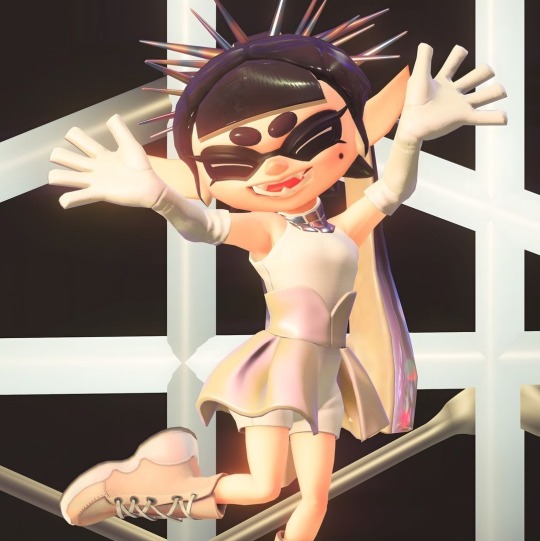
Now in terms of the Squid Sisters being underutilised? I 1000000% agree with you. Despite them being the OGs, their stories have been mishandled and to be honest, we don't know much about them compared to Pearl and Marina.
This single image put me into a frenzy because they actually SHOWED shit from their past which is something that Nintendo rarely does....
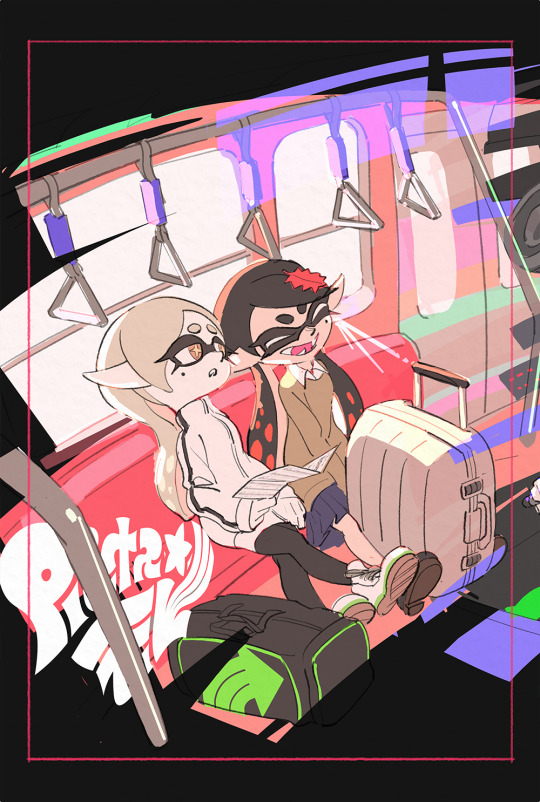
Off the Hook in their story modes got optional lore content decided to THEM!!!! They had chat logs and a FUCKING DIARY!! WHAT DID THE SQUID SISTERS GET IN SPLATOON 2?!?! A COUPLE OF SUNKEN SCROLL ENTRIES THAT BRIEFLY TOUCHED ON IMPORTANT STORY DETAILS THAT PEOPLE DONT FUCKING TALK ABOUT!!!!!! RAHHH!!!!! (And a prequel tie in story that no one gives a shit about aside from youtubers explaining Splatoon 2's hero mode and then saying Callie was KIDNAPPED AND BRAINWASHED 5 SECONDS LAT-)
In Splatoon 3 ROTM, same deal, we got cute pics and some sunken scroll entries and that's it.
I love Off the Hook! I really really do but oh my GOD I hate how they hog up all of the cool lore and backstory details man!!!! Why do Off the Hook get to have more personal story modes yet the Squid Sisters don't?!
ROTM was the perfect opportunity but they didn't do ANYTHINGGGGG! The Squid Sisters were just comediac relief and that's so disappointing CONSIDERING WHAT HAPPENED IN THE LAST GAME!!!! I like their jokes and they bring a warm energy to the story, but how they were handled vs. Off the Hook in Side Order is a night and day difference!
And now people online say that they don't want them to come back?!?!? I saw a video about a guy rambling about Splatoon 4 and what he wanted to see. And hearing him say that he doesn't want the Idols to return because "oh it's an end of a trilogy. They shouldn't come back." Really pissed me off, to be honest.
The Squid Sisters feel incredibly underutilised and their story modes were heavily botched. Especially Splatoon 2's.... the shit I see about that story mode still persists till this day and it's making me go bananas... but you know already. Ugh... the blatant disrespect people have over Callie....
I just hope they make a come back for Splatoon 4. I dont need them right away but I just hope they make some substantial appearance in Splatoon 4 and go on a new arc that explores the duo further. A Side Order/Octo Expansion type of story for the Squid Sisters with Agent 4 or something would make me so.... happy...
Also, just wanted to say too, poor fucking Deep Cut, I hope they don't suffer the same fate as the Squid Sisters.
(First photo by frequent.squidsisters on Instagram)
#splatoon#splatoon 3#callie cuttlefish#callie splatoon#marie splatoon#marie cuttlefish#squid sisters#ask blog#ask me stuff#ask me anything#splatoon 2#off the hook#pearl and marina#deep cut#side order#octo expansion#splatoon 4
21 notes
·
View notes
Text
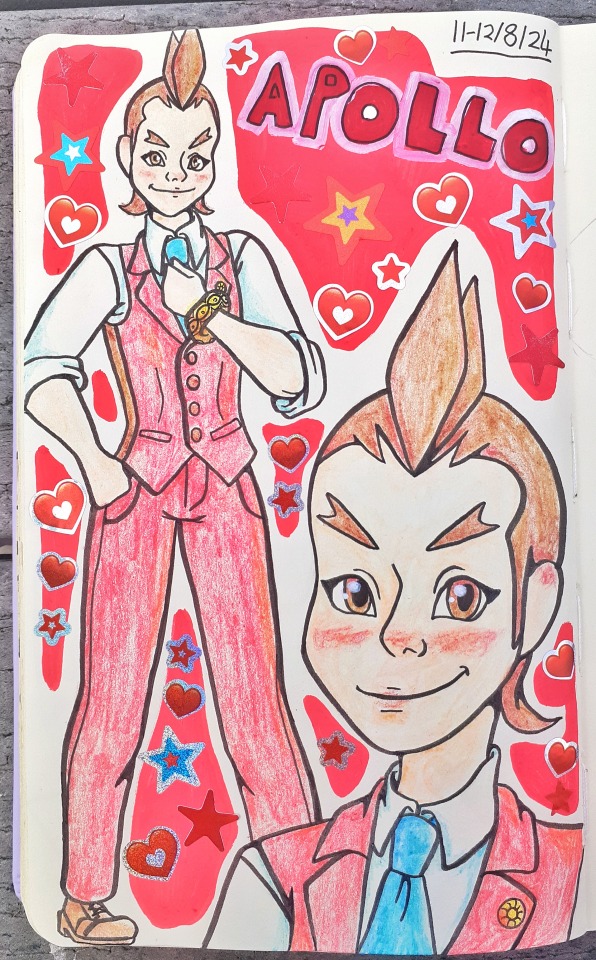
✭ Apollo Justice✭
Today I decided that I will do more full page drawings of AA characters. Unfortunately I don't think I drew a very good Apollo, but in my defence AA is the frist franchise I've hyperfixated over were I've not only cared about the more than one or two male characters but also have had a few of my favourite characters be male! So I'm much more comfortable drawing female characters (´-﹏-`;)
Also I didn't change up his design aside from giving him the brown shoes he has in the AJ: trilogy promotional art instead of black shoes he has in older official art because I like it and it's actually my second fave lawyer suit design (favourite is Diego Armando's suit).
Anyways I've also decided I'll share my hc's for these characters for as long as I do this series :D, because I didn't share hc's for Athena on her post I'll share both Apollo and Athena hc's below, spoilers for AA4-6:
Both Apollo and Athena are trans and both socially transitioned as kids and grew up in trans supportive environments cuz in my mind the AA universe is queer friendly to balance out how dystopian their legal system is.
Apollo has no fashion sense aside from having a surprisingly good eye for men's formal/professional wear. So good in fact that Kristoph wouldn't of hired him if his suit looked bad (cuz he's that petty).
Apollo doesn't see Phoenix as a Dad but does simultaneously see him as a role model (though he'd never admit it) and hate him
he does however see Trucy as a little sister, even before learning she is actually his half sister
Apollo is gay and Athena is lesbian cuz one day I thought "hmmm image if the lawyers were trans and MLM and WLW solidarity?" and than it became a hc :P
I ship Apollo with Klavier and I like to think that Phoenix tries to give Apollo dating advice but Apollo ignores him because his advice is terrible! (Not on purpose, Phoenix is just really bad at relationships but it's works out for him cuz his partners are always just as bad, or somehow even worse at relationships than him)
however unlike Apollo I don't ship Athena with anyone, just don't feel like it lol
Athena met Phoenix in Europe at a park one of the many times Miles had him and Trucy come over to visit, by chance Trucy was doing magic tricks for random people in the park and Athena was one of these people. She was reading a book to study for the bar exam so Phoenix immediately talked to her about law after Trucy's trick.
Athena is fully multilingual (knowing most active European languages) and says non-english words by accident most of time (if she does it on purpose it's always to sound cooler in her opinion).
also I hc Athena as Austic cuz I can >:-)
Widget uses a Voicaloid sound bank, personally I like it imagine it's specifically Oliver because that's funny to me.
Widget also uses a custom OS that Aura Blackquill designed specifically for all the tech she built with Athena's mom.
#ace attorney#apollo justice#aa#ace attorney fanart#ace attorney art#ace attorney headcanon#artists on tumblr#traditional art#sketchbook page#sketchbook art#cyanaa#cyansketchbook#cyanfanart#cyanart
23 notes
·
View notes
Note
Voting sticker was sent via DMs because it's shaped like the state I live in lmao. Also, if someone reading this is in Fly Free or Die by some minuscule chance, please look away now; there be spoilers ahead.
The character I'll tell you about is RH-1/Istra Gryffis/Cassiopeia Wulfren/Stellasa Drith, a Human Replica Droid in an SW5e campaign. Originally an Imperial Agent, she was sniffed out by the scientist she was monitoring on her very first assignment, subdued by him, had her programming jailbroken and a teleportation device installed in her chest, and was then just turned loose on the galaxy to make her own way.
She still believed herself a tool of the Empire, but a broken one, who failed in her mission, and couldn't bring herself to go back to her handler/creator/mentor so spent a few years just roaming the galaxy aimlessly doing small time security work.
Eventually, a smuggler she was contracting with (one of her party members) got into a Situation with a crime syndicate, and the pair had to run off into corporate bureaucratic hell to escape their eyes--or rather, the smuggler did; she suggested that specific approach because the last she knew the scientist who jailbroke her had been planning to go work for that corporation. With danger pushing her toward decisive action for the first time in years, she took that as a sign to go and hunt him down to bring him back to the Empire and get back in its good graces. And, perhaps, demand to know why he shoved a unique piece of tech into her chassis then just left her to do what she wanted with no guidance whatsoever.
Regardless, working for this corporation put her and her smuggler buddy into the party, working shipping as contractors for a major corporation. The details of our current, first arc are, while interesting, also mostly unimportant to what I want to talk about regarding party dynamics/info.
Essentially, the party (who don't know she's a droid) includes her, the smuggler (always getting himself into situations), a clone (hates droids), two droid-specialist engineers (one who just unreservedly loves droids and the other who isn't exactly pro droid rights but wants to rehabilitate their image), and a (secret) Jedi. Various dynamics:
The smuggler is someone Cassioepia's decided she's responsible for the well-being of, because she develops strong loyalties very quickly (great trait for a spy).
Thus far, there have been multiple arguments over droids and how much they matter (she comes down on the side of "just tools, and unreliable ones" like the clone does, if less adamantly).
The clone appears to be coordinating at least a few small rebel groups, and is very anti-Empire, as well as looking to her as essentially his second-in-command.
The clone and one of the engineers are on opposite sides of idealism-cynicism, and she's had to mediate a couple times now.
Finally, in the most recent session, the Jedi used Sense Force (equivalent to Detect Magic) on her. Said Jedi sensed nothing from her since she's a droid, EXCEPT the teleportation device in her chest, which sucked the Jedi's perception in, knocked her out, gave Cassiopeia a heart attack essentially, and knocked her out (also granting her, a droid, Sense Force as well) and that's where Cassiopeia left off.
Word count (after the 1st paragraph since that's unrelated): 518
(Quick note: if you're reading this, yes, DM-ing me the sticker/proof is an option if the sticker reveals more about your location than you wish to share (whether it's that you don't want to share your state, or whether you have a county or city-specific sticker, or what); I will not tell people where you live.
so I do NOT know a ton about SW5e (I saw Starstruck Odyssey and I have seen. the original trilogy and like. 4 other Star Wars movies, none comprising a full other trilogy?) but I love when a character has complicated and conflicting loyalties and a strong sense of duty, which she clearly has, and that is a GREAT cliffhanger that seems primed to absolutely blow your party's collective mind and reveal a whole lot of messy truths, and that's really the best possible thing you can hope for in a TTRPG!
13 notes
·
View notes
Text
So you want to know about Oz! (2)
In 1986, an anime was released in Japan: Ozu no Mahoutsukai (which is just "The Wonderful Wizard of Oz" in Japanese).

This animated series was an adaptation not just of "The Wonderful Wizard of Oz", the first Oz novel by Baum, but of all those that would follow! You had book 2, "The Marvelous Land of Oz", and book 3, "Ozma of Oz"... But then we jump to book 6, "The Emerald City of Oz", which forms the grand conclusion of the series. Book 4 and 5 were not adapted... completely cut out.
Why? Because these two books are, unfortunately, skippable.
Last time I left you on the enormous, ever-growing success of the original Oz trilogy. Now I want to present you... the curse that befell the creator of Oz.

L. Frank Baum wasn't just "the guy who wrote The Wizard of Oz". He was an author for children first and foremost, and he wrote a LOT of other books outside of his Oz stuff. His other most famous children work to this day, the only one able to rival his Oz creation, was his 1902's The Life and Adventures of Santa Claus, which was a work of fictional fundamental in the development of the modern image of Santa Claus:
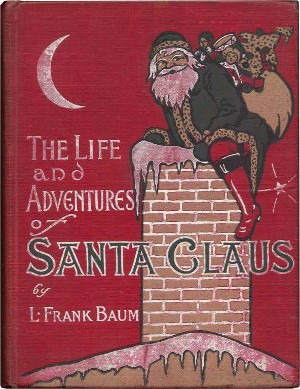
But this was truly the only one of his other works that escaped the shadow of the Oz-mammoth... Before and in parallel to his Oz trilogy, Baum had written many other things. "Mother Goose in Prose", "American Fairy Tales", "The Enchanted Island of Yew", "Queen Zixi of Ix", "Sam Steele's Adventures on Land and Sea", "John Dough and the Cherub"... But none of these books became as successful or famous as his Oz novels. Worse: they sold really bad.
Everybody wanted Oz books. More Oz books, more Oz books! And while Baum had quite some fun working on "The Wonderful Wizard of Oz" and "The Marvelous Land of Oz"... he had never intended to serialize them. For him they were stand-alone novel, and that was done. But since his audience only asked for more Oz books, and disdained his other works, well, he had to do what paid! And so he continued the Oz novels... but with a certain "bad will" that clearly transpires in his work.
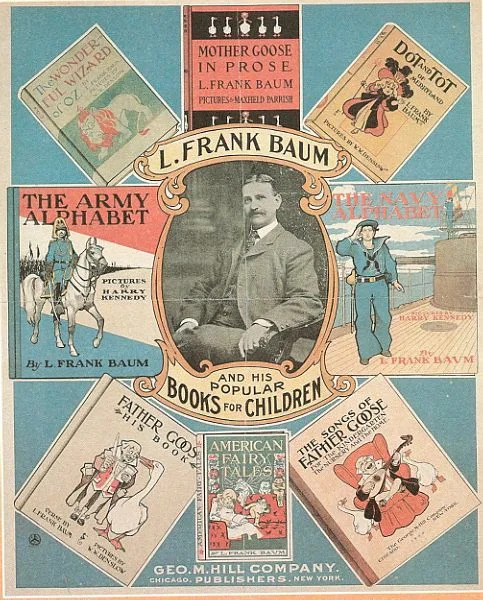
This already pops up by the third Oz book, "Ozma of Oz".
The first two Oz novels followed a specific rule: the story must happen in the Land of Oz, which is a magical land enclosed and shielded from the rest of the world. The Land of Oz is surrounded by a gigantic desert that one cannot cross unless exceptional events. Beyond this, is the human world... Yes, that's something people tend to forget: in his original vision for the Land of Oz, Baum wanted this magical land to be... somewhere on the American continent. Right in the middle of the 1900s American nations. Hence how a simple tornado can carry a little girl from Kansas to Oz... This is also explicitely told in the second book, where the characters cross the desert by accident, and discover "the world Dorothy came from".
But by Ozma of Oz, the rule was broken. Dorothy gets carried away by a storm in... a new land, the Land of Ev, who as it turns out exists outside of Oz, beyond the desert... Ozian characters cross the desert and join Dorothy in this new land, and most of the story is spent discovering this entire new setting.
While it is very pleasant and delightful to read, and brings some interesting worldbuilding, this already betrays the annoyance Baum was starting to feel towards Oz itself... He had written two novels taking place in Oz, and he was starting to run out of ideas. He had conceived two self-contained novels, two "one-shots" if you wish, and had no idea how to continue within Oz itself. So his solution was to take the characters everybody loved and wanted (he did brought back Dorothy in "Ozma of Oz" BECAUSE his audience kept asking him "Why wasn't Dorothy in the sequel?), but place them in a new "magical land" where he could have a breath of fresh air and work a new plot. This is what makes "Ozma of Oz" so interesting... But it was what would cause the start of the Oz downfall...
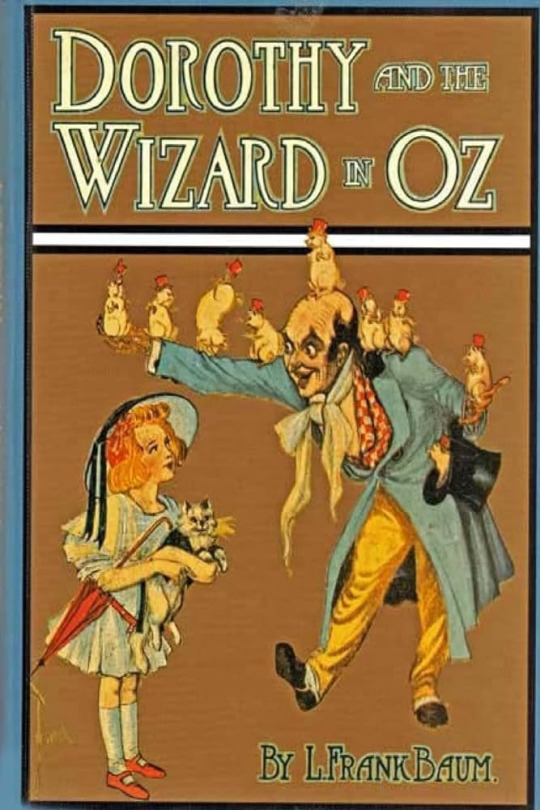
In 1908, Baum published "Dorothy and the Wizard of Oz", the fourth book of the Oz series. And a good part of this novel is... Dorothy, alongside the Wizard of Oz himself (who returns after his last appearance in the original novel), ending up sent into an underground realm, and exploring various magical chthonian lands as they try to make their way back to the surface... The last portion of the story does take place in Oz, mind you, but the bulk of the story is in random lands and realms Baum invented just for this book and never reuses later. Because at this point, Baum, who was stuck into doing Oz books but didn't want to continue Oz-stories, had decided to use a trick: only have the Oz protagonists but not the Oz land. Have Oz appear in the last chapters, but only after two thirds of adventures everywhere but in Oz. This was his way to still give what the audience wanted (more Oz adventures) without actually writing Oz books, but rather other fantasies that happened to connect with Oz...
This formula would be repeated with the fifth book of the series, which I'll talk about later, and unfortunately it creates a sincere drop in quality in those two novels. While very inventive, and entertaining to a certain extent (if you ignore some heavy doses of racism and old-fashioned xenophobia here and there), these novels are not as good or memorable as the original trilogy, and for one precise reason... They have no over-arching plot. They are just... travel stories. You have a set of characters, swept away into magical lands, travelling the lands, then partying in Oz and returning home. Gone is the "Quest to have our wish granted" of the first book, gone is the "national revolution mixed with a quest for a lost heir to the throne" of the second book, gone is the "let's save an imprisoned royal family" of the third book... Now it's just "Oh, looks like we randomly dropped into a fairy-land! Let's promenade a bit and then return home". An "Alice in Wonderland" type of non-plot, basically... but without the Alice in Wonderland charm.
Things are even sadder when you look at the fifth book of the series, "The Road to Oz".

At least with "Dorothy and the Wizard of Oz", there was a semblance of a mini-plot at the end, when everybody arrived in Oz. You had criminal charges and a trial, and competition-debates as to whether mundane or magical beings are better... But with "The Road to Oz"? You have literaly zero plot. The characters just get dragged from vision to vision, from land to land, and when they arrive in Oz, it is just to have a party, and then they literaly return home once it is over.
But the true desperation of Baum comes from this specific party... Because what Baum did in this novel was maybe the first "crossover event" of the history of American literature. All of the guests at the party are characters that never appeared before in any of the Oz books so far... They are characters straight out of Baum's other, non-Oz, children books! Characters from "The Magical Monarch of Mo", "Queen Zixi of Ix", "John Dough and the Cherub", and many other books you probably never heard about (and that the Oz readers at this point also never heard about!). Yet these characters were described in detail and given quite a space in the final act of the book...
This was because Baum was tired of Oz hogging all of the attention and money. He was so sad at seeing his other children works be forgotten and ignored by mass audience that he literaly decided to bring them into his Oz series in hope that it would interest his Ozian readers and encourage them to check out the other books he did. Yes you heard it right, this novel... as just an big ad for Baum's other books. That's how tired he was of Oz.
And, unfortunately for him, it did not work...
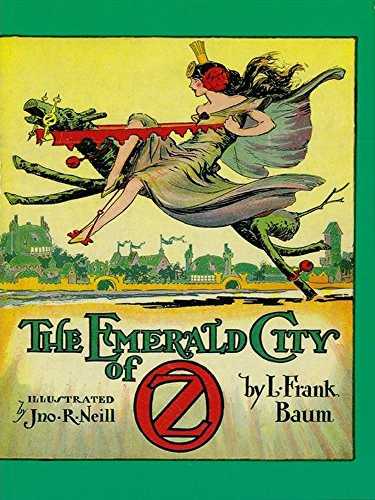
Cut to 1910. L. Frank Baum releases his sixth Oz book "The Emerald City of Oz"... that he also intends to be his final.
With "The Emerald City of Oz" we have the grand finale! Dorothy decides to leave Kansas and to settle permanently in Oz! She brings with her Aunt Em and Uncle Henry who are given a complete tour of the Land of Oz! Meanwhile the greatest and most terrible ennemies Oz ever faced gather for an invasion! And, in the final chapter, Glinda the Good Witch decides that enough is enough, Oz had enough troubles from the outside world: she casts a spell that will make Oz unreachable by anyone from the human world...
And thus, Baum with teary eyes says goodbye to his character, and encourages his audience to say farewell to Oz, as the gates of the Marvelous Land close forever...
THE END
...
Who are you kidding? No, not the end! Cursed, Baum was, CURSED! Despite him writing EVERYTHING needed for the grand, conclusive finale, despite him literaly writing "IT'S OVER GET OUT"... His other books didn't sell. His other series didn't start. And he kept being pressured by all sides to write more and more Oz books.
As such, by 1914... a seventh Oz book was made. Opening with Baum writing basically "Sigh... So you know how I told you no other Oz story could be made, because there's this magical barrier and I will never know what happens behind it anymore? Well... sigh... turns out they have radio, somehow? And so... double-sigh. And so I have broadcast in Oz, which means... you'll get more Oz books."
Next post: How we got a HELL LOT of more Oz books
#oz#land of oz#l. frank baum#the emerald city of oz#oz books#road to oz#dorothy and the wizard of oz#oz novels#history of oz#so you want to know about oz
38 notes
·
View notes
Text
IWTV Ep3 Musings - Claudia & Louis (Spoilers)
I'm still teary & choked up while typing this. SUPER emotional episode. It's incredible how much they packed into one ep, too! But the second half of the ep was BY FAR the most emotionally impactful IMO. Jacob's acting is just WAY too good; he had me choking up something fierce.

Louis taking pictures of his food for no effing reason like all the social media girlies do; I love it.

Louis STILL tryna be Claudia's knight in vengeful black. U_U But just like before when he tried to save her from Lestat, he can't save her from Bruce or the Theatre or even his own eff-ups. DANG. 😔

YES YOU DO. If you wanna keep pestering her about trauma she doesn't want to think/speak about, then be prepared for the consequences.

AMC, you GOTTA kill Bruce on-screen for us, either in QotD during all the Burnings, or during the PL trilogy (Killer's death was GNARLY).
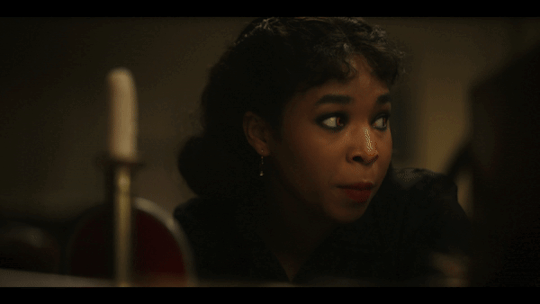
LOOK AT MY DAUGHTER ALMOST CRYING RIGHT THERE. God's strongest soldier, she's suffered more than Christ, JUSTICE FOR CLAUDIA. All rapists deserve the death penalty, IDGAF.

Understatement of the century.

I CACKLED at that literal DEMON TIMING. Armand was already AT the door while y'all were concocting your lies! Then he just strolls on in, uninvited! 😭
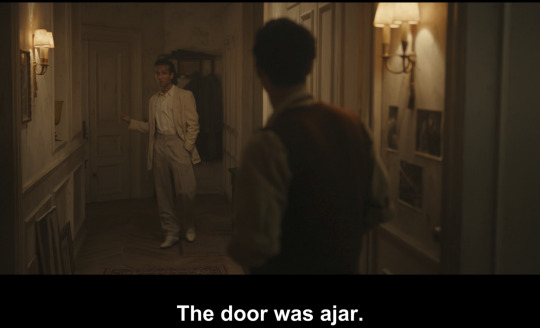
BULLSH!TE. Not that it matters, since vamps have SUPER-HEARING and can READ MINDS, you morons! Pack your bags and go back to America RIGHT NOW. 💀💀💀

Louis, beloved, bless your heart, but if you don't take your garbage attempts at lying back to NOLA and stop playing with this ANCIENT immortal dressed in all white like the effing BOSS PIMP you USED to be.....

Alpha DADDY Maitre Armand Sir, I take back every bottom Uke Omega joke I ever said about you~! 😍

Yeah, about all that.... 😬

Aaaaannnnnd THIS is where you effed up, Claudia.
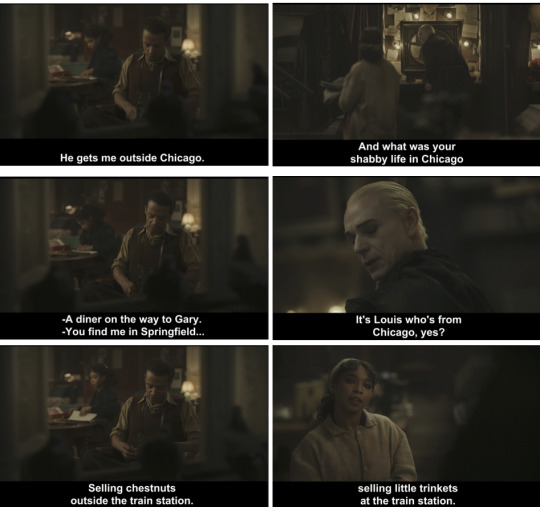
And Armand heard the WHOLE THING. 😭

Look at her FACE. 😭😭😭😭

They KNEW she hated being treated as a child, and they KNEW her time was numbered cuz she lied about breaking their Great Laws, so they DELIBERATELY made the "Baby LouLou" role to humiliate her, and EXPLOITED her image to bring in extra revenue (how many BLACK actresses did they ever have in their coven/stage? ZERO); all while KNOWING they were gonna kill her and Louis ASAP.

youtube
I hate this Theatre coven with ever fibre of my being, Maitre.

Excellent point, Louis. Cuz I noticed in Ep2 that their apartment is kind of crappy--I assumed it was cheap & low class cuz of the tenants all being college students & sex workers, and I noticed a bunch of chipped paint everywhere; on the doors & walls.
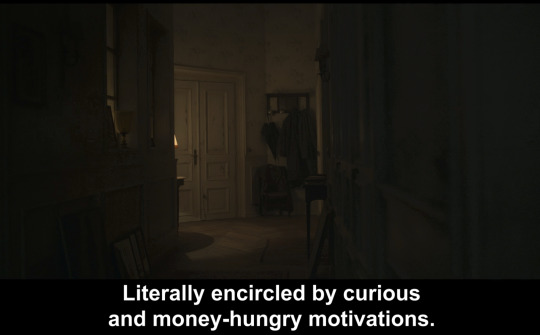
They're slumming it in a studio, sleeping in the living room, as neither has their own room & she has to use a Murphy Bed. Major step below 1132; the exact opposite of how book!Claudia & Lou lived in Parisian opulence--highlighting my point that AMC!Claudia got NOTHING out out being a vampire.
But it's also pointing out how Louis covers all the cracks--in his MIND, in the lies he tells himself, just to live with the glaring problems he desperately wants to cover up & deny.

I'm finna yeet myself out the nearest window.

This is SO bizarre, cuz in this version Lou KNOWS Lestat's not really dead! In the book Lou set him on FIRE. So ofc he'd think Les was really dead. But here it makes no sense why he's carrying all this guilt!
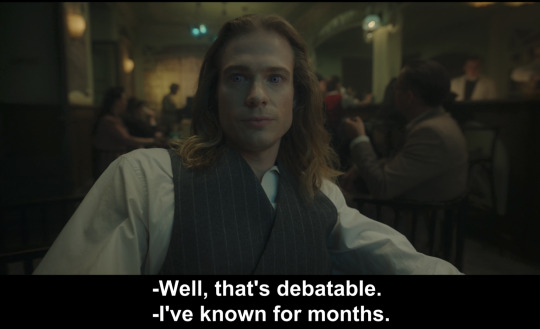
Armand knew Lou & Claudia LIED, sure--but he SHOULD know Lestat's still ALIVE--he's probably chained up in the Theatre basement in one of those friggin "wet room burial vaults!"

THANK YOU.

The guilt is out of control. Louis, if Les couldn't tell you loved him after ALL OF THAT, then he's a effing fool who neither understands nor deserves you. Now go chop his d**k off!

Is that what you tell yourself when DreamStat's in bed with you every night? ( ͡° ͜ʖ ͡°)
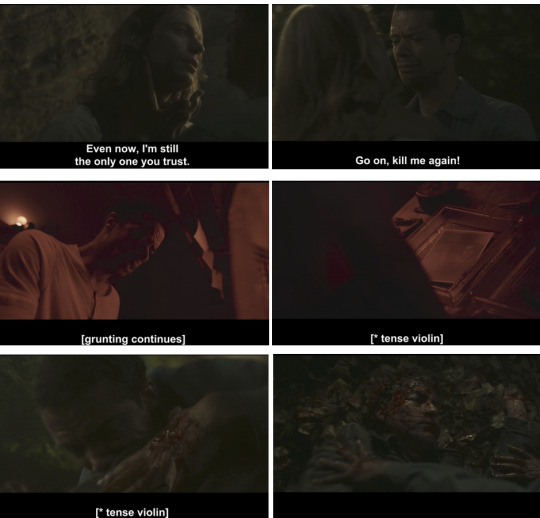
I haven't seen mental trauma treated so well in Horror media since Senua's Sacrifice; this is incredible. 👏
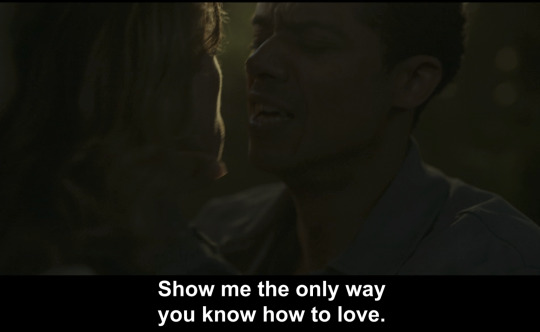
Lou, give yourself a bit more credit--you're doing the best you can! :( Even if your best is an entire travesty. U_U

NOBODY TALK TO ME!

Just when I thought she was having a breakthrough, she doubles down on thinking Lestat lied to them about Europe being terrible. 🤦

(The way Lou clutches his pearls like he's having a heart attack--STOP it, ma'am~! 👌) And YES, you should've told her that you folded and spilled the beans to Armand and that she was walking into a trap, WTF!?! 😡

Jacob, your GirlDad is showing; PLEASE have mercy on us! 😭
EMMYS. 👏 GRAMMYS. 👏 OSCARS. 👏 TONYS. 👏
#interview with the vampire#iwtv season 2 spoilers#iwtv tvc metas#louis de pointe du lac#justice for claudia#the feels#THE FEELS I TELL YOU#must see tv#the hype is real#Youtube
29 notes
·
View notes
Text
THE 2018 DENGEKI BUNKO INTERVIEW WITH 86--EIGHTY-SIX AUTHOR ASATO ASATO
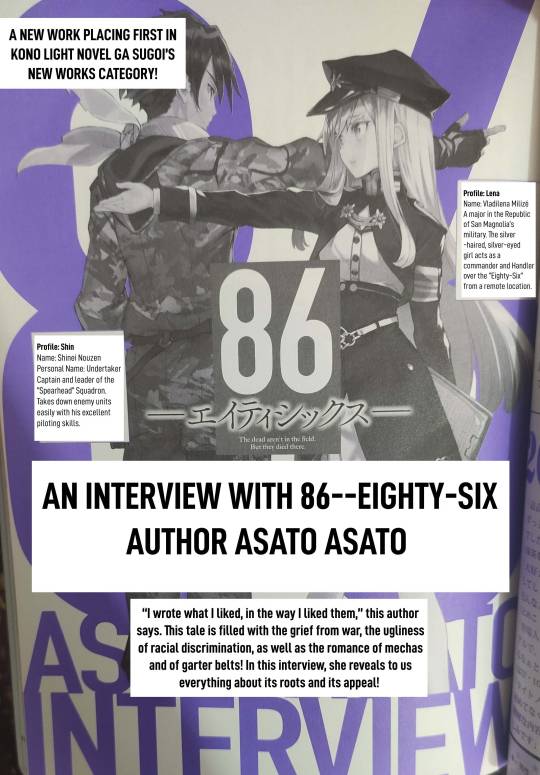
Disclaimer: This translation is made by me for fandom purposes only. This interview, conducted in 2017, gives major insights on how the sci-fi mecha series 86--EIGHTY-SIX was conceived and written before it eventually won the Dengeki Novel Prize back in 2016.
Please ask my permission and credit me+this post if you will be re-translating this to other languages. PLEASE DO NOT REPOST ON YOUTUBE AND TIKTOK AND PLEASE DO NOT REPOST THE IMAGES ON THIS INTERVIEW. Please take the fan translations here with a grain of salt.
Credits to @Yashamise from Twitter for copies of this Dengeki Bunko Kono Light Novel ga Sugoi magazine.
Erratum: This interview was conducted and printed in 2017, but this Kono Light Novel ga Sugoi magazine is dated 2018 as an advance issue of sorts. This interview has been summarized here. My apologies for the title.
I’m posting my Ko-Fi here as currently, I’ve been having financial trouble regarding my medicine, so if anyone can donate, I would be much grateful for the help, thank you very much.
AN INTERVIEW WITH 86--EIGHTY-SIX AUTHOR ASATO ASATO
“I wrote what I liked, in the way I liked them,” this author says. This tale is filled with the grief from war, the ugliness of racial discrimination, as well as the romance of mechas and of garter belts! In this interview, she reveals to us everything about its roots and its appeal!
Text and Composition: My Street
Illustrator: Shirabii
Translator’s Note: For purposes of this interview translation, the interviewer will be labelled as “MS” for My Street, since they layouted and probably conducted this transcribed interview. Also, for words that have brackets or parenthesis:
{} = implied by context
() = given emphasis/given parenthesis in the interview itself
[] = included in the footnotes/translator’s notes
A robot lover as far as she could remember
MS: Thank you very much for your time today for this interview. It was surprising to learn that the author {for 86--EIGHTY-SIX}, Ms. Asato, is a woman.
ASATO: I get that a lot (haha). My family says the contents of my work is just “the usual {for Asato}” though. I think my Afterwords have the impression they’re written by a woman, and I never hid that in particular (haha).
MS: This year {2018}, 86--EIGHTY-SIX placed first in the New Works category and second in the bunkobon {paperback} category overall. How do you feel about this now?
ASATO: I’m very happy. I knew of KonoRano’s existence [1], so I was hoping {86--EIGHTY-SIX} might be listed there somewhere, but it was a surprise that it placed higher than expected. As I said in this interview’s foreword: “I wrote what I liked, in the way I liked them.” I’m thankful that many readers found it interesting.
MS: For readers who haven’t heard of 86--EIGHTY-SIX, can you give us a summary of this work?
ASATO: It’s a lively, filled-with-clanks story of the protagonist Shin, his merry band of thieves, and their remotely-working-class-president Lena. [2] (LOL)
MS: 86--EIGHTY-SIX is your debut work. Can you tell us about the time you started writing this work?
ASATO: I’ve been writing ever since I can remember, and I started with writing manga {scripts}. I switched to writing novels around before I started junior high school and have been writing them ever since.
MS: You’ve been interested in robots and military-related things ever since elementary school, is that right?
ASATO: Yes, that’s correct. My mother liked {Space Battleship} Yamato [3] and Gundam, and as I have a younger brother, I got into watching and reading anime and manga targeted at boys. I was rarely exposed to anime and manga targeted at girls. We had the Mobile Suit Gundam movie trilogy [4] at home (which I’ve seen many times), and I also watched The Brave Police J-Decker [5] and The Brave Express Might Gaine [6], as well as other shows in The Brave [7] series. The only anime I had watched that is {targeted at girls} is Magic Knight Rayearth [8], which is another story with robots fighting in it (haha).
MS: I reckon such an environment led you to writing 86--EIGHTY-SIX. Can you tell us about your writing process?
ASATO: I originally submitted {works} to the Kadokawa Beans [9] Bunko Newcomer Awards. I avoided the Dengeki Novel Prize as it was rather {too hard to enter} due to the large number of entries [10] there. The novel entry I made on the 21st year of the Dengeki Novel Prize (2014), however, was totally not aimed at women at all, so I didn’t have any other choice but to submit that to said contest, as it has the closest deadline. It was a sci-fi fantasy work, with a theme of redemption, set on a time before and after {a} revolution. At that time, I thought, maybe I can go past beyond the 3rd round of screenings and unexpectedly, maybe placed on a good spot? However, the evaluation I got from the judges were “This is a 100% a work targeted at girls” and “Next time, we hope you will submit a work that should be Dengeki Bunko-like”. As Dengeki Bunko [11] is an all-kinds-of-genre publication, I didn’t know what ‘Dengeki Bunko-like’ even meant. I thought about it a lot but couldn’t figure it out, so I just kept on writing and finished my next entry, which is 86--EIGHTY-SIX.
MS: How did you come up with the idea and structure of 86, a war drama where unmanned drones and “unmanned manned drones” battle each other?
ASATO: I once read a newspaper article whose main message was “It won’t be good if a country sends its citizens to war, but it shouldn’t be a problem if they made an army of foreigners fight in their stead.” In that case, I felt very afraid that other people will be forced to fight instead of us, with the idea of “those aren’t people, but drones” justifying this and everyone just allowing it {to happen}.
MS: As written in Volume 1’s Afterword, looking back at history, it. is true that racism and racial exclusion existed to no small extent. So, why did you decide to incorporate “racism” into your work?
ASATO: Ever since I started writing novels, I have repeatedly written about boundary lines between “human beings and those who are human but not treated as human beings”, with 86--EIGHTY-SIX being in a similar vein. One of the bases for this is probably the class discrimination found in Final Fantasy Tactics [12], for example. A character there, Argath, who is an aristocrat, tells a commoner character: “But the gods have no eyes for chattel! [12]” This line has stayed with me ever since. After that, I continued to write with the motifs of “human beings and livestock in human form” and “human and those considered not humans”. I think BLACK/MATRIX+ [13] influenced me as well. This game deals with ethnic discrimination, set in a world where black-winged people are ruled over by white-winged people. In there, those who were discriminated against were treated harshly. They were treated like livestock, with the game having this line of, “Why is a mere slave like you wearing clothes?”
MS: Do you often play games?
ASATO: When my gaming consoles weren’t connected yet to the Internet, I used to play a lot of RPGs. I’m not good at action games. I did play a lot of Final Fantasy, like Final Fantasy VI, Tactics, VIII, IX, and X [14].
MS: Are there other works which influenced you? I wonder if there’s something similar like the war situation in Knights of Sidonia [15], which was mentioned in Volume 1’s afterword.
ASATO: I often watch a lot of robot shows, Knights of Sidonia included. In addition to the Gundam series mentioned earlier, I also watched Full Metal Panic [16] and Gunparade March: A New Song for the March [17]. It’s not a robot series, but I also have read Battle Faery Yukikaze [18] over and over. I like {literary} structures where the protagonist side is overwhelmingly inferior while the antagonist side is the superior one. I want to see the flow of emotions from the characters more than the fight scenes themselves. I think emotions such as fear, resignation and desperation show more in situations where {characters} are hopelessly in a big disadvantage. Winning a battle by domination can be exhilarating, yes, but those other emotions don’t show as much during that. That’s why I prefer for the protagonists to win through unrefined and tenacious means, rather than them winning by outsmarting {enemies}.

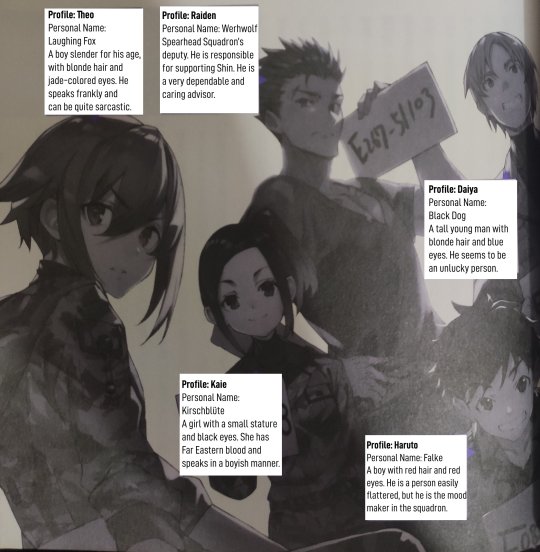
The work’s influences from horror films and in-depth military research
MS: The Legion are getting more ominous, and the deteriorating situation for Shin and his group is putting them on a very big disadvantage, if I’m not mistaken.
ASATO: 86--EIGHTY-SIX has been influenced more by horror movies than robot anime, with it being based on movies such as The Mist [19] and Screamers [20]. Mist is a horror story where the protagonists get trapped in a supermarket due to a mysterious fog and monsters, and the people gradually lose their ability to make rational judgments as they are unable to defend themselves or escape, without any rescue in sight. This horror movie has a great ending, so I’m inviting you all to watch it without further spoilers. 86--EIGHTY-SIX was initially set as a novel about a fog of nanomachines covering the walls outside of the Republic, and the “Legion” being an aggregation of said nanomachines. However, that kind of thing couldn’t exactly be defeated by conventional weapons, so it was rejected at the setting phase. These elements from this setting, however, were retained in the form of Volume 1’s final boss character and the appearance of those electromagnetic jammers clouding the sun.
MS: It’s rather surprising this came from a horror setting.
ASATO: The other {inspiration mentioned earlier}, Screamers, is a sci-fi horror film where autonomous war weapons evolved on their own and went out of control. In 86--EIGHTY-SIX, the Self-Propelled Mines, which look like wounded soldiers, are based on Screamers. The work is rather interesting as one has no ideas who their enemies are and everything else looks suspicious.
MS: So you have a situation like this, and you applied what kind of emotions you want to be shown in that situation, correct?
ASATO: Yes. Looking back, I think I was strongly influenced by the novel Chaos Legion [21] {in this regard}. Shin’s Personal Mark, which has a shovel on it, was influenced by his special ability as well as his role being the “Undertaker” responsible for collecting the fragments of his comrade-in-arms’ {Feldreẞ} units.
MS: The more I hear about it, it seems this work is really packed full of things {you} like.
ASATO: While I was writing this, I played the Black Hawk Down [22] movie repeatedly instead of just background music. It’s also a favorite {movie} of mine.
MS: I would like to ask you about military-related matters. What kind of material did you use for your research?
ASATO: I borrowed all relevant materials I use from the library, so I don’t have any specific references… About racial discrimination, I read materials about Nazi Germany [23], the internment camps in US as well as the 442nd Infantry Regiment [24] and Scroll of Agony: The Warsaw Ghetto Diary [25]. As for the weapons, the Juggernaut and the Legion are based and patterned from tanks, so I’ve read materials dating back from World War II [26] as well as the Gulf War [26], where 120mm tanks were the main weapons used. The Juggernaut’s 57mm cannon wasn’t used very often, so I had a difficult time finding research material for it. The unit itself is based on the M551 Sheridan [27]. This airborne assault tank has aluminum alloy armor, but the Juggernaut reflects the pitiful aspect of said flimsy armor which explodes upon impact by any stray attack.
MS: Why did you make the Juggernaut and the Legion multi-legged tanks?
ASATO: Because it’s romantic! I love multi-legged tanks! My first exposure with them is the X-ATM092 [28], a spider-shaped mobile unit from FFVIII. The loud, resounding footsteps it produced as it chased you away was very scary, and it left this impression of being a symbol of a very powerful weapon. I also like Ghost in the Shell’s Tachikoma [29] and the Tobigumo from the Swallowtail novel series [30]. In reality, multi-legged tank units aren’t really fast enough, and there is too much ground pressure for those to actually carry a 120mm cannon… but I make up for it with my imagination (LOL)
A character that embodies the idea of “to be human” walks alone
MS: Concerning those people called “Eighty-Six”, what do you think it means “to be human”, which you tried to depict in Volume 1?
ASATO: What I tried to depict in this work is “to respect other human beings, and to live without regrets.” However, I don’t think everything I wrote in this main part is actually correct. I think this is the answer the “Eighty-Six” came up with due to the environment they lived in. In Volume 2, the stage now shifts to the Federacy, so the theme there is now what will happen if said environment has changed.
MS: In Volume 2, I see this as a story where the “Eighty-Six”, who managed to get safety for the time being, nevertheless still returned to the battlefield. I think this sentiment was portrayed very well.
ASATO: Volume 3 will focus on what happens inside {Shin’s head} after he made that choice, so please look forward to that. After all, they don’t feel safe even after coming to the Federal Republic of Giad. And the war against the Legion isn’t over yet. Since the Eighty-Six think they will not survive if they don’t fight, I think they will continue to fight until the Legion disappeared. Then… what will they do after the Legion are eventually gone? …They will certainly have to think about that in the future as well.
MS: Do you have a favorite among all the characters?
ASATO: It’s Raiden. Of course, I love the two protagonists, Shin and Lena, but Shin isn’t really a very cooperative character with me, so I have a certain attachment to Raiden, who provides much support. Instead of simply just crafting the plot, I write in a way that captures how each character would act in line with {the type of} world I've created. That’s why I do not know what the characters think, what goals they have, or what pasts they bear unless they “talk” to me. Shin is not the type {of character} to talk about anything in particular, and he doesn’t even say anything much except for his name. It wasn’t until I finished writing that climax of a battle in Volume 1 that I realized what he was fighting for. After I wrote it, I was like, “Huh?! So, this is it?!” and was surprised as the author (LOL).
MS: So, you didn’t think about Shin’s background at first?
ASATO: Yes, that’s right. During that climax, I finally understood {everything} concerning Shin, so I went back on that part and wrote the details that I then added.
MS: So even at the plotting stage, you haven’t put together the {setting and background} for each of the characters?
ASATO: To begin with, when I wrote Volume 1, I haven’t even made a plot. I didn’t even have a story structure in particular, and just wrote while letting the characters act. The first time I finished this volume, the last two pages were still missing, but Shin brought them to me, saying, “Sure enough, write up to this far.”
MS: What happened after Volume 2?
ASATO: I have submitted the plot… but stressed on the important scene that “I won’t know everything until I write it” then submitted it. As a result of this, only the boss character from Volume 3 remained in that plot I submitted. {I caused} my editors a lot of trouble.
MS: How did Frederica (the character) come to be?
ASATO: Frederica is a character with a part further on in the series, so I intended to debut her in Volume 2. As I was writing her, however, it seemed she and Shin have similarities on what they carry on their backs. Since then, she acts as a mirror to Shin. As Shin is a character who is not very good at grasping his own emotions, {I had Frederica} serve as the one who verbalizes those emotions. I wondered then, what does it mean to have a 10-year-old verbalize {another person’s feelings}? (LOL) I simply wanted to show a little girl. In Volume 2, the heroine, Lena, is absent, but I can’t have another girl the same age as her as this volume’s heroine… and so, under this pretext, I brought out {Frederica as} the little girl heroine.
MS: For some reason, I thought there’s other many works featuring little girls in the battlefield.
ASATO: If this were about a real battlefield, it would have been filled with old men. I like older men soldier characters, so that would have been fun to see, but I don’t think readers would find that interesting. Cute little girls adding a touch of color {to a work} is important (LOL).
MS: Did you decide on the setting from the start?
ASATO: The setting was generally decided from the beginning. The scenes were written out as needed. For example, regarding the battlefield, the Legion are ground-based weapons, and it would be troubling if they’re easily eradicated by aircraft weapons. That’s why {I had} the Eintagsfliege, a Legion unit which has jamming, and restricted the use of aircraft and communication devices. This, however, would have prevented Shin and Lena from communicating with each other, so I then devised the special communication device called the Para-RAID.
MS: How deeply did you think about this world’s setting on itself?
ASATO: The necessary scenes have been chosen in detail, otherwise, the rest of the details aren’t fixed. For example, it’s not in the main story, but the Republic’s population has already been decided upon. It’s the reverse with the countries on the edge of the continent that aren’t scheduled to appear, as they might have a Chinese-like culture… that’s all I thought of it right now. There’s also this “sensory tuning”, which hasn’t been written in the setting yet, but is scheduled to be involved in the future part of the plot. However, as I said just a short while ago, the story {as a whole} is influenced greatly by how the characters act, so it depends on them to make the best use of the setting. From this point on, who will survive and who will die… is something that I still don’t know.
MS: Is it still unknown how the war against the Legion will move forward?
ASATO: The basic points {for that} have been decided, with the foreshadowing being built onto step by step. However, it is up to those two, Shin and Lena, if they will follow suit. (LOL)
MS: What about the Legion, then?
ASATO: About the Legion, the setting about them has been solidly established, including the future boss characters. However, I can’t say anything about them yet. Details about them have been foreshadowed little by little. I write hoping the readers will be surprised by this later.
The love for garter belts explodes! A talk about eroticism
MS: Changing the subject, what it is about your particular fixation towards garter belts [31] and pilot suits [32], both of which you spoke so passionately about in your Afterwords?
ASATO: About the pilot suits, on the outline for volume 2, I wrote "I don’t want men’s pilot suits paired with ground-based armaments!!!" using half of the A4 outline paper and submitted that (LOL). I’ve wondered whether pilot suits are really necessary, apart from space or aircraft or even ground battles. I’ve my doubts about it, and with said doubts I don’t want {characters} just wearing pilot suits, even in a robot thing. I do agree with the editor-in-charge about “Female pilot suits are justice!” so Lena wearing a pilot suit is scheduled to appear in the future [32]. After all, the garter belt shows a good place between sexy and cute. I think the eroticism {from the garter belt} dwells in its self-contradictory element: it’s just one additional item {in a set of clothes}, and somehow manages to show more skin―I think that’s the charm of the garter belt. In particular, if the color {of the garter belt} contrasts strongly with the skin color {of the wearer}, the impression of bare skin is more emphasized in spite of the wearer. Because of this, I think it’s wonderful that Shirabii colored the belt part {of Lena’s garter belts} black.
MS: It’s amazing the garter belt drawn by Shirabii has the functions of both a belt and a ring, isn’t it?
ASATO: Furthermore, Lena’s military uniform, a garment that is very much seen in public, has garter belts, which are usually private items, and I think that adds further to her ambivalent charm even more. As a matter of fact, at first, I argued that it would be better if {her} thighs were not visible all the time but could be glimpsed at occasionally, but after a 2 AM discussion with the editors-in-charge while looking at the rough draft of the cover art, they convinced me that “That ‘occasionally’ should be now!”, and we settled on its current form. The ideal situation {we have} was when {Lena} lifts her legs up and a glimpse of the black lace garter can be seen through the slit of {her} dress. However, as Lena is a prim and proper lady, the only situation I can think of where she lifts her legs while wearing a dress is when she is about to wear heels… I’ll have to ask Shin to do his best on this one.
MS: Rather a difficult situation, isn’t it?
ASATO: It’s Shin, after all. Also, a military uniform with pretty boy shorts + sock garters is also cute, and as Theo hasn’t appeared with his military uniform yet, I’m thinking to add that to his outfit now… (LOL). However, middle-aged soldier uncles shouldn’t show their bare legs with shirt garters! (Editor’s note: Please Google “shirt garters” for more info)
MS: Are there any {role/inspiring} models for your characters?
ASATO: Basically, none. However, as mentioned earlier, Shin is partly inspired by Sieg Wahrheit [33] from Chaos Legion, while Lena is partly inspired by General Garrison [34] from Black Hawk Down. In the film, {Garrison} is placed on a situation where he could do nothing but only communicate with his subordinates in adverse circumstances, and this inspired Lena’s position {in the series}. In Black Hawk Down, many characters died before we even understood them, and I think that influenced 86--EIGHTY-SIX as well.
MS: That’s right. They die when the chapters change. When you are writing, you’re writing without knowing who is going to die, isn’t it?
ASATO: There are some characters whose manner of death came to mind as I was writing them. I think they’re good kids, but I have no choice but to let them face their fates (oops).
MS: If the names of the Eighty-Six characters were names of Japanese people, would they still make good names?
ASATO: Yes. All their names can be written in kanji. For example, Shin’s surname, “Nouzen” is from the kanji of the Chinese trumpet creeper (凌霄花) {pronounced as “nouzenkazura”} [35]. I actually like the arrangement of the kanji {from that plant} within the kanji for “surpassing the sky” (霄を凌ぐ) {pronounced as “sora wo shinogu”}. If you use the same kanji and put the honorific (君) {pronounced as “kun”} on it, you can form the characters for the Eurasian goshawk (凌霄君) {pronounced as “ryoshoukun”} [36]. This is also a reference to Shin’s image, as he does resemble a hawk.
What’s next for this series? There’s so much more to write about!
MS: What will happen in Volume 3 of 86--EIGHTY-SIX? [37]
ASATO: It will be properly connected to Volume 1’s Epilogues, so please don’t worry about that. The battle scenes, which were limited in Volume 2, will be much increased here. It might be even tragic.
EDITOR KIYOSE: This paperback series will, of course, continue to be serialized, and the series will also be expanded into various adaptations such as comics [38] and other various media. This work will have a lot of side stories, so we hope you will all appreciate this series as a whole.
MS: Can you please tell us about the future developments of 86--EIGHTY-SIX?
ASATO: The stage has shifted to the Federacy from Volume 2, and as the war situation gets more violent, the environment surrounding the Eighty-Six and the others is about to deteriorate further. There will be new enemies for mankind to face, and their own numerous personal conflicts standing on their way one by one. However, they have survived far difficult circumstances up until now, and since Lena will join them in earnest by Volume 4, I think they will still survive, stubbornly, shamelessly, and boisterously. However, I really wouldn’t know what would happen unless I write them. (LOL)
MS: How many volumes does this series will have?
ASATO: Currently, I'm thinking of around 13 volumes. The war against the Legion has a general flow and an ending in sight already, so I'd like to get to that point first. In addition to that, I’d like to like to write a side story about Raiden and Shin when they just first met, if I have the opportunity [39]. There’s so much more I want to write about. From Volume 4 onward, countries other than the Federacy will be related, and there’s plans to stretch out the stage even more. The Queen's Knights [40], led by Lena, will also make their appearance. I think there might be some slight surprises about Shiden, who first appeared in Volume 2.
MS: Lastly, any message for the readers who have supported you and the series?
ASATO: I was never active on the web at all, and I was totally an unknown newcomer writer. I believe the reason why I and the 86--EIGHTY-SIX series have come this far is due to the readers who picked up the books and supported us. So, everyone, I will do my best to write bringing Shin and Lena and the Eighty-Six’s battle to conclusion, so from this point on, I look forward to your continued support!
{End of Interview}
Translator’s Notes (Most of the blurbs here are taken from respective relevant Wikipedia articles, and the notes also include the Magazine Notes from the actual interview):
[1] Kono Light Novel Ga Sugoi: Kono Light Novel ga Sugoi! (このライトノベルがすごい!, lit. This Light Novel is Amazing!) is an annual light novel guidebook published by Takarajimasha. The guidebook publishes a list of the top ten most popular light novels according to readers polled on the Internet and votes from critics, influencers, and other people related to the light novel industry. 86--EIGHTY-SIX ranked 2nd and 5th in the bunkobon category here in 2018 and 2019.
[2] Lena is the class president of Class 2-E in the 86--EIGHTY-SIX Operation High School spin-off side stories and the manga. This is probably among the first references to said spin-off.
[3] Space Battleship Yamato: one of Japan’s most influential sci-fi/mecha series, a Japanese science fiction anime series produced and written by Yoshinobu Nishizaki, directed by manga artist Leiji Matsumoto, and produced by Academy Productions.
[4] Mobile Suit Gundam: The first series in this very popular Japanese military science fiction media franchise, it was re-released into a film trilogy in 1981.
[5] The Brave Police J-Decker: The fifth installment in the Barve series.
[6] The Brave Express Might Gaine: The fourth installment in the Brave series.
[7] The Brave mecha and sci-fi series: a Japanese toy and anime franchise Brave series made by Takara and Sunrise, and currently owned by Bandai Namco.
[8] Magic Knight Rayearth: a mecha, fantasy and isekai shoujo manga series made by the all-female manga artist group CLAMP.
[9] Kadokawa BEANS Bunko Award: The contest launched by Kadokawa’s female-focused light novel imprint, Kadokawa Beans Bunko.
[10] Dengeki Novel Prize: a literary award handed out annually (since 1994) by the Japanese publisher ASCII Media Works for their Dengeki Bunko light novel imprint, spearheaded by parent company Kadokawa. It is among Japan’s largest light novel contests, with more than 4500 entries submitted annually. 86--EIGHTY-SIX won 1st place in the Rookie Awards category in 2016, launching it to the spotlight.
[11] Dengeki Bunko: a publishing imprint affiliated with Kadokawa’s ASCII Media Works. Many anime adaptations from light novels were published by Dengeki Bunko, including 86--EIGHTY-SIX.
[12] [Magazine Note 1] Final Fantasy Tactics: A tactical simulation RPG released in 1997. The socially conscious storyline, which tackled friction between nations and the gap between the rich and the poor, became very much a hot topic during its time.
Please take note I used the Final Fantasy Tactics: The War of the Lions translation here as contextually I believe this translation has more in line with EIGHTY-SIX than the translation of the actual game Asato played, which is the original Final Fantasy Tactics. Also, Argath vs Algus :3
[13] [Magazine Note 2] BLACK/MATRIX+: A tactical simulation RPG for Sega Saturn, with the PlayStation port released in 1998. It has a unique setting where virtue and vice are said to be reversed.
[14] Final Fantasy: a fantasy anthology media franchise, first and mainly developed as RPGs, owned, published, and distributed by Square Enix. Currently this franchise has 16 main series game releases. One of these games, Final Fantasy VIII, has its main soundtrack (“Eyes on Me” by Faye Wong) featured on the Afterword of 86--EIGHTY-SIX Volume 7: Mist.
[15] Knights of Sidonia: A sci-fi/mecha seinen manga, made by Tsutomu Nihei and ran from 2009-2015 in Kodansha’s Monthly Afternoon magazine. Its anime adaptation, which ran for two seasons, was produced by Polygon Pictures and aired from 2014 to 2015.
[16] Full Metal Panic!: a series of mecha light novels written by Shoji Gatoh and illustrated by Shiki Douji, published by Kadokawa’s Fujimi Fantasia Bunko and ran from 1998-2011. Its anime adaptations were produced by Gonzo, Kyoto Animation and Xebec respectively, from 2003 to 2018.
[17] Gunparade March: A New Song for the March: The anime adaptation for the Playstation video game Gunparade March, produced by J.C. Staff and aired in 2003.
[18] Battle Faery Yukikaze: a Japanese military science fiction novel series written by Chouhei Kambayashi. Its five-episode OVA adaptation ran from 2002-2005.
[19] [Magazine Note 3] Mist: A 2007 film based on the award-winning science fiction horror novella by Stephen King.
[20] [Magazine Note 4] Screamers: A 1995 futuristic science fiction horror film, based on Phillip K. Dick’s novelette “Second Variety”.
[21] [Magazine Note 5] Chaos Legion: A mixed-media action RPG released in 2003, getting a novelization by Tow Ubukata.
[22] [Magazine Note 6] Black Hawk Down: A 2001 war movie. Based on a non-fiction work about an actual urban war between international forces and guerillas that occurred in Somalia. The film depicts how a UH-60 Black Hawk gets taken down and this being dragged into a war situation.
[23] This is a very extensive subject, so please feel free to check out Nazi Germany on Wikipedia to get at least an overview.
[24] Another extensive subject, so feel free to check out 442nd Infantry Regiment on Wikipedia to get an overview.
[25] [Magazine Note 7] Scroll of Agony: The Warsaw Ghetto Diary: A diary kept by a Jewish teacher, {Chaim A. Kaplan}. It described the persecution and pillaging by the Nazis, as well as the three harsh years of {Kaplan’s} life.
Printed in Japan as (ワルシャワ・ゲットー日記―ユダヤ人教師の記録 or “Warsaw Ghetto Diary: A Jewish Teacher’s Record”), with Kaplan implied to have died in 1942 when he was sent to the Treblinka death camp along with other Warsaw Jews.
[26] Another extensive subject, so feel free to check out World War II on Wikipedia to get an overview. Feel free to also check out Gulf War on Wikipedia to get an overview on this topic.
[27] [Magazine Note 8] M551 Sheridan: an American tank developed to be amphibious, airborne tank. Its body was made of aluminum alloy to help reduce weight, but this made it vulnerable to anti-tank weapons and land mines, and it could explode when the shells it’s equipped with are triggered.
[28] X-ATM092: A spider-like robot boss enemy found in Final Fantasy VIII.
[29] Tachikoma: a blue-colored AI walker/roller tank that looks like a spider in the Ghost in the Shell cyberpunk media franchise.
[30] Swallowtail series: The sci-fi novel series written by Chitose Touma and published by Dengeki Bunko in 2008. The series is about artificial fairies, androids created in the form of humans, to be companions to still-living humans after parts of Tokyo’s population were wiped out in a pandemic, and one of these fairies, Ageha, is investigating a serial killer causing destruction. The work also has this multi-legged armored tank called “Tobigumo”. So far as I know this mecha doesn’t have official art, however, a fanart can be found in Pixiv here.
[31] [Magazine Note 9] Garter: They’re suspenders of sorts. “Garter belt” is the term for {a fabric strap which} which is clipped on over-the-knee socks or stockings. Having no shorts above garters is righteous! between the rich and the poor, became very much a hot topic during its time.
Asato’s interest in garter belts is not only shown in the novels, but also in the anime, which is noted to have a lot of thigh shots of Lena wearing said garter belts.
[32] [Magazine Note 10] Pilot suit: In this case, this is the type of suit that sticks really close to the body. As it shows the body lines quite clearly, it’s considered quite fetishistic.
In the current time, 86--EIGHTY-SIX Volume 5: Death, Be Not Proud, has already been published, and Lena did wear the Cicada, which is Asato’s homage to pilot suits.
[33] Sieg Wahrheit: the protagonist of Chaos Legion.
[34] William F. Garrison: a retired major general of the United States Army who commanded United States forces during Operation Gothic Serpent including the Battle of Mogadishu, which served as an inspiration for the novel Black Hawk Down.
[35] The Chinese trumpet creeper, a native flowering vine species found in East Asia, usually in China, can mean “fame”, “honor”, “glory”, “abundant love” and “life filled with flowers” in the flower language.
[36] Eurasian goshawk: a medium-large bird-of-prey found in Europe and Asia and is among the species considered as “true” hawks. The kanji used in the article actually just refers to how Shinei Nouzen looks like a hawk, but upon further examination of said kanji in this reference, it pertained to that goshawk as well.
[37] Volume 3 of 86--EIGHTY-SIX was just about to be released in Japan around the moment this article was published, serving as a promotion of sorts.
[38] Several manga adaptations of 86--EIGHTY-SIX have been published as of current time. For more information, please check out this 86 Reddit Manga FAQ for further details.
[39] Besides Volume 1, Eighty-Six’s Interlude: Headless Knight II, Asato has managed to write this in the side stories Volume 10, Fragmental Neoteny Chapter 8: The Banks of Lethe and Alter.1: Claymore Squadron.
[40] The Queen’s Knights, formally known as the Brísingamen Squadron, was the squadron Lena became the Handler with after the Spearhead Squadron was sent on the Special Reconnaissance Mission. It was led by Shiden Iida and was pivotal in the Republic of San Magnolia’s defense during the 1st Legion Large Scale Offensive.
#86 eighty six#86#エイティシックス#86 ーエイティシックスー#86 エイティシックス#86 anime#asato asato#dengeki bunko#86 light novel#86--EIGHTY-SIX#eighty six#vladilena milizé#shinei nouzen#安里アサト
62 notes
·
View notes
Text
CREEPY Steve
2024 is the 50th anniversary of Stephen King’s first published novel, CARRIE. The story of a bullied telekinetic teen, who gets blood-soaked payback at her prom. Since then, he's written 65 novels, 200 short stories, and 5 nonfiction books. A freakish feat, almost worthy of one of his supernatural characters.

King’s first published story was when he was 19 years old. He continued selling short stories after graduating from the University of Maine, and while teaching English at a public high school, all later collected in NIGHT SHIFT. He's averaged more than a book a year since 1974. Many of his novels were initially released under a pseudonym, lest their sheer number dilute his ‘brand’. I became aware of King via the early movie adaptations of his books. CARRIE, THE SHINING, and THE DEAD ZONE. A great introduction, as those early films were all good, whereas most adaptations of his work are terrible, sadly.
During one of the Halloweens in the covid era, Julia & I got into a CREEPY STEVE frame of mind. Watching the better film adaptations, and listening to audiobooks. Those narrated by Will Patton were faves, as he really brings the characters to life. The Bill Hodges trilogy - Mr MERCEDES, FINDERS KEEPERS and END OF WATCH - were all marvellous, and introduced the wonderful character Holly Gibney. Who then appeared in further stories of her own.
There are 10 Stephen King short story collections, and all that I’ve read contain several gems. JUST AFTER SUNSET has the terrifying (yet somehow hilarious) tale of a man trapped and left for dead in a capsized porta-potty. DIFFERENT SEASONS contains the stories that inspired THE SHAWSHANK REDEMPTION and STAND BY ME. Donald Sutherland starred in a great film entitled Mr HARRIGAN’S PHONE, taken from IF IT BLEEDS. Which also contains another great Holly Gibney story.
ON WRITING: A MEMOIR OF THE CRAFT, is an engaging book, narrated by the author himself. Part memoir and part how-to instructional. Reminding me of William Goldman’s ADVENTURES IN THE SCREEN TRADE, in that it can’t truly deliver the secrets to making the magic that it promises, but serves up entertaining & revealing autobiographical anecdotes instead.
We are now used to seeing vampires in contemporary settings, so some of the 1970s impact of SALEM’S LOT has been lost. But both the book and its movie adaptation have many indelible images. Such as a vampire child hovering at the window.. (an inspiration for John Ajvide Lindqvist perhaps?)
After listening to book after book of King’s, and loving their brilliantly observed characters, and wonderful dialog, DARK TOWER was conspicuous for not having the elements that are normally intriguing in his books. Maybe I’ll give this series another shot someday, as friends swear it gets better.
We read THE SHINING and its sequel, DOCTOR SLEEP, watching & enjoying both movie adaptations. King apparently despises Kubrick’s version of THE SHINING - "The book is hot, and the movie is cold; the book ends in fire, and the movie in ice. In the book, there's an actual arc where you see this guy, Jack Torrance, trying to be good, and little by little he moves over to this place where he's crazy. And as far as I was concerned, when I saw the movie, Jack was crazy from the first scene.”
After reading the book, I understand King’s critiques, and agree with his second point. Jack Nicholson seems already about detonate on his drive to the hotel. Whereas King’s Jack was driven to madness by the malignant spirits within it. However, Kubrick’s film is so indelibly stamped into my mind, that I cannot unsee it. Nor unlike it neither (sorry, Stephen).
“Plot is, I think, the good writer’s last resort and the dullard’s first choice. The story which results from it is apt to feel artificial and labored.” - Stephen King.
I work in storytelling too, but in my biz it’s the dullard’s choice all the way - everything plotted & discussed, ad infinitum. King apparently starts with the merest idea, then writes straight ahead, surprising himself as he goes. A magician pulling a string of goodies out of his own head. At his best, this approach produces stories that feel naturalistic, with surprising twists and turns.
At his worst, it can be rambling, meandering and self indulgent. Especially when he struggled with addiction. Apparently, King was so out of control in the late 1980s, that he was confronted by an intervention after finishing the TOMMYKNOCKERS manuscript. A pity then that the editor wasn’t given more latitude in tidying up that waffling mess before it went to print..
Stephen himself agrees - “I mean, The Tommyknockers is an awful book. That was the last one I wrote before I cleaned up my act. And I’ve thought about it a lot lately and said to myself, “There’s really a good book in here, underneath all the sort of spurious energy that cocaine provides, and I ought to go back.” The book is about 700 pages long, and I’m thinking, “There’s probably a good 350-page novel in there.”
We enjoyed the screen adaptations of IT, CHRISTINE, 1922, THE MIST, and 11.22.63. After soaking in worlds King has created, on page & screen, it became clear that the recent NETFLIX hit, STRANGER THINGS, is merely glorified Stephen King fan fiction. By the end of the pandemic, we’d chewed through many stories, yet only a mere fraction of The King Catalog.
King is thought of as a master of the paranormal, but his real genius is for the everyday. Some of my favourites King stories are his straight crime fiction, or stories about real life. Even his famous horror stories are grounded by settings in relatable blue collar situations.. The writer Peter Straub even compared King to Dickens: “Both are novelists of vast popularity and enormous bibliographies, both are beloved writers with a pronounced taste for the morbid and grotesque, both display a deep interest in the underclass."
How does a man who’s been a millionaire for decades, with a very recognisable face, keep an ear for dialog patterns of common folk? Does he wear a disguise, and lurk in truck stops, diners, dive bars, and greyhound bus stations, taking notes?
“He's one of the first people to talk about real Americans and how they live, to capture real American dialogue in all its, like, foulmouthed grandeur... He has a deadly ear for the way people speak... …Surface-wise, King's work is a bit televisual, but there's really a lot going on." - David Foster Wallace
Lately, we’ve embarked on yet another quest to chip away at the KING oeuvre. Having already fallen in love with Bill Hodges & Holly Gibney, it was fun to watch the Mr MERCEDES TV series. Even though the filmmakers took liberties with the characterisations. Rather than the shy, smoking, middle aged, OCD woman of the novels, the TV Holly is a perky & cute 30 something. An autistic variation on the manic pixie dream girl trope. (sigh..)
Taken from a short story collection entitled EVERYTHING’S EVENTUAL, the gripping movie 1408, starring John Cusack & Samuel L. Jackson, is the creepy story of a skeptical paranormal investigator, whose cynicism is challenged by spending a harrowing night in an actual haunted hotel room.
In THINNER a selfish fat lawyer is cursed into anorexia by a gypsy. Entertaining, in 'the guy deserves everything he gets' manner of a parable from the Twighlight Zone. It seems to have inspired Sam Raimi's DRAG ME TO HELL.
GERALD’S GAME seemed like a story written on a bet, or an author’s exercise - “write a novel where the protagonist never leaves their bed for most of the story.” To me it felt like it might have worked better as a short story. When King fails (for me, anyway) it's when there hasn't been enough editing.
King has apparently said that PET SEMATARY was his book that scared him the most, and it is extremely creepy, but for me, MISERY was even more terrifying. I'd already seen the film, and Kathy Bates’ Oscar winning performance, but the book is even scarier somehow. There’s nothing paranormal about this story. There is utter horror, but it is the worst kind that there is - the twists & turns of the human mind.
Despite, or perhaps because of, King’s great popularity, literary critics long damned him with faint praise. In 2003, when he received the National Book Foundation’s ‘Medal of Distinguished Contribution to American Letters’, some became openly hostile:
"The decision to give the National Book Foundation's annual award for "distinguished contribution" to Stephen King is extraordinary, another low in the shocking process of dumbing down our cultural life… ..What he is is an immensely inadequate writer on a sentence-by-sentence, paragraph-by-paragraph, book-by-book basis." - Harold Bloom
Bloom is dead, so King gets the last word - “A lot of today's reviewers grew up reading my fiction. Most of the old critics who panned anything I wrote are either dead or retired".
In 1999, Stephen King was flattened by a vehicle while walking along a highway - "After the accident, I was totally incapable of writing. At first it was as if I'd never done this in my life. ...It was like starting over again from square one." As someone who was been flattened too (but in a very different way) one of the many inspiring things about King is how he recovered from that terrible accident, to do some of his very best work.
CREEPY STEVE is a one-man multimedia idea engine, keeping the publishing & Hollywood machines running. We are still enjoying poring through the King library (listening to THE INSTITUTE now) so if any of you have further recommendations, please let me know in the comments!
#essay#stephen king#illustration#The Shining#pet sematary#salems lot#supernatural horror#horror movies#horror fiction#holly gibney
13 notes
·
View notes
Note
What do you think about Norman's pre death line ("Peter don't tell Harry")?
Alright once again reiterating that the tag Norman slander exists simply to allow people who don’t wanna see this to block it. I get it. Negativity is just gonna come with the territory of who this character is, but I also understand if you simply don’t want to see it. That’s why that’s there.
I really don’t think this is as well intentioned as people make it out to be. Frankly I think it’s arguable that it’s mainly just a plot device that’s probably easier to try and retrofit into any interpretation than it’s actually meant to align with anything but that’s beside the point.
I have gone into a perhaps frightening amount of depth onto why the like, main Norman defense scene in the Raimi trilogy doesn’t actually make him look that good. I won’t rehash that all here, if anyone is interested in reading it’s linked.
That being said, considering the selfish and malicious undertones to how he interacts with Harry in pretty much every scene, I don’t know if I’m really meant to read it as a benevolent or well intentioned move. I can’t even say if many of my points here that I would have would even be conscious for Norman or really just be more of a subconscious desire to preserve his power and his image. At the end of the day, because this line is primarily a narrative device, I don’t really care about the intention of that line. It’s secondary to what it represents later on for Harry, Peter, Norman’s flaws, and Norman’s lingering presence.
Norman functions both as a character and a narrative device, because at the end of the day all characters are narrative devices. The perceived humanity of any character is, unless it breaks the suspension of disbelief, often less important than what they accomplish as a narrative device. Often times, Norman analysis can end up falling flat to me because there’s a prioritization of the perceived humanity of a character over what they’re accomplishing for the narrative. At the end of the day, whatever interpretation of him makes the rest of the narrative the most compelling and the strongest is the most important. I say that Norman is a narrative device because at the end of the day, the influence I read from this line that might not be logical as his thought process or as a non cartoonishly evil intention are more important to me than trying to figure out a way where that thought process makes any damn sense. This is Doylist vs Watsonian, when it comes to this line I personally think it’s going to be easier if Watsonian interpretation that contributes to my hesitance because of how hard it would be to make the following make any damn sense as Norman’s conscious intentions plays second fiddle to the personally far more interesting ideas of what this accomplishes from a Doylist perspective. Overly long explanation accomplished, let’s move on.
Norman as a narrative device is primarily a foil for Peter. Give a man a mask and you see who he really is. Peter chooses to do good with little reward while Norman is effectively using anonymity as a tool to get what he wants, which is primarily control. Every scene with the Goblin is preceded by a scene where Norman experiences something, usually negative, that gives him a reason to want to do something drastic. He is using anonymity and his physical power with the Goblin to effectively try and eliminate anything that threatens the power he already has as an influential and wealthy person. It’s easy to interpret it’s about control for him from that; he is doing whatever he can to control every factor to prevent anything from threatening that he has what he wants and wants to continue to have it, regardless of what extremes he needs to go to or who his need for control harms in the process, because at the end of the day his need for control is entirely selfish. This contrasts well with Peter, who makes the conscious choice to help others regardless of the cost to himself because he believes it’s the right thing to do and those people deserve that protection and the ability to live safely. Norman/the Goblin quite literally states that he views the masses as a tool to elevate himself, a mentality that Peter’s actions do everything they can do prove that he doesn’t buy into as a character beat for him. Peter is choosing to take on a massive, selfless burden to himself and use the power he has, power he could use to exert control over people like Norman does, to instead help others and elevate them, rather than using them to elevate himself. This is the primary point of the movie, hence why it’s reiterated and expanded upon so much: the most important part of the movie is showing that Peter is a benevolent person who is learning that his power is best used to protect and elevate others, instead of using them to elevate himself. Norman being his foil, what aspects of his character strengthen that arc are more important.
Therefore, it’s easy to read that in Norman’s purpose as a character, that’s about control. It’s also an easy plot device just from that—he is exerting control over how his son sees him, a fun and cool plot device that will allow Harry to experience the horrors later on. He only demands Peter don’t tell Harry, but he effectively eliminates anyone else from knowing in the same move. If Harry can’t know, Peter can’t create any way for the public to know. That preserves Norman’s name in regards to many of the things he’s shown to care about. It’s also a sort of double bind for Peter if he ever even wanted to tell someone: he’d have to explain that he’s Spider-Man and the reasoning behind why preserving the last wish of a terrorist is more important than letting that be public and letting Harry make his own decisions. He’s never stated to tell MJ, because MJ would probably question these things and I think Peter knows that! At a certain point, Peter probably felt he was in too deep and that being his last words became more of an easy excuse for Peter to not have to do the main thing he struggles with: have difficult conversations. From every angle, letting Harry continue to suffer without all the details is a bad move… but after not telling Harry for months, is it too late to explain himself or for letting him hurt to be inexcusable? After a year? After the two years that we are shown in the time between the first two movies? It’s no longer if it’s more important to help the very alive Harry than respect the very dead Norman, it’s now that Peter is in an impossible situation where both options feel wrong. Anyone would be angry he hid that for that long, but the more time that goes by, the reaction becomes even more likely to be explosive, especially as Harry sinks into quite literal clinical delusion. And that’s not even really digging into the fact Peter just avoids those sort of difficult interactions in any way he can.
The idea this line is more of a narrative device is more clear when it comes to Harry. At the end of the day, this line exists to rationalize and make more believable Peter’s refusal to talk about it as Harry slowly experiences a pretty harsh psychological decline. I half resent this because I wish Peter’s avoidance was allowed to exist as its own flaw, but I also understand the line preserves suspension of disbelief. Harry is near constantly lied to by the people in his life, something that creates the distrust that makes him so much more dependent on his largely selfishly or maliciously acting father, even in death. Harry’s an odd specimen as a fictional character who’s a child of abuse, considering he’s shown to idolize his abuser instead of hate him—and yes, I am going to insist on the idea Norman was emotionally abusive at best. It’s in the text.—so having this sort of control via this line and his hallucinations is another narrative element to contribute to the idea that Harry stepping away from his father, existing independently from his attachment to Norman and Norman’s influence on him and towards the people who love him for himself and the creation of his own identity is the best thing for him. I understand liking Norman, especially in a post-NWH world, but there’s a reason he is the quite literal face of all of Harry’s worst traits, worst decisions, and the things that allow him to continue causing himself pain.
My primary opinion on this line is that it allows Norman, even after death, to keep exerting a deep control over almost every major character in this trilogy. That is its purpose, because that control makes the rest of the narrative more solid and more interesting. You can’t just remove this element without consequences. His intentions are very secondary for me, because I just don’t think they’re that important, though I doubt it was good intentioned on any more than a conscious level because it doesn’t align with the tone of every single other interaction with Harry and the idea that a line that has this sort of influence was meant to be helpful just has incredibly strange implications on so many levels.
#harryposting#harry osborn#raimiverse#raimi trilogy#spider man#spiderman#peter parker#norman osborn#norman slander
13 notes
·
View notes
Text
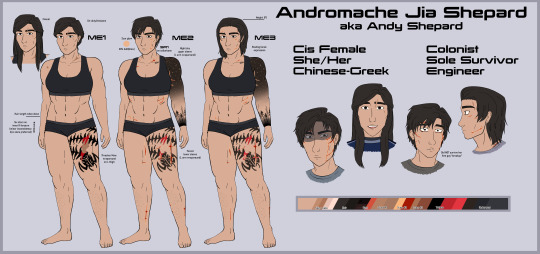

Revisited my old Liaramancer, Andy (also the only character I've played through the entire trilogy) after like 2/3 years! Probably the biggest ref I've done for a character haha
More character info +ID under the cut:
Andromache "Andy" Jia Shepard Age: 29/31/32 (ME1/ME2/ME3) Morality/leaning: Paragade Sexuality: Bi + demi Romance: Liara Weapon(s) of choice: Sniper rifle, tech
Born in Thessaloniki, Greece, as the middle child of five children, Andy moved to the off world colony Mindoir with her family at the age of 10. They lived a peaceful life there for six years before the colony was attacked by batarian slavers, leaving her the only survivor of her parents and siblings. She was taken in by her aunt and uncle, and moved to Vancouver, Canada, to live with them. She studied computer engineering at a military school in the city, eventually transferring into the Alliance military after graduating.
Most of Andy's military fame prior to serving on the Normandy is attributed to her experience on Akuze, where she was the sole survivor of fifty-one marines after a thresher maw attack, managing to get back to the extraction point thanks to her perseverance, quick thinking, and sheer luck. After this incident she was admitted into the N7 operative program, eventually graduating and earning the rank of Commander.
When on the job, Andy is clipped and professional, always trying to act reserved, though at times her emotions get the better of her. Outside of work, she struggles to connect with people and has difficulty turning her "professionalism" switch off, though she tries her hardest to be approachable. After her "death" and subsequent reconstruction (in ME2) she is much more brutal and upfront. Feeling like her life and all control of it was yanked away from her, she cut her hair and got new tattoos as a way of leveraging some control of herself. Although she ultimately wants to help others, she feels bitter and angry at the fallout of her death and the organization that resurrected her for their own means, Cerberus.
By the time of the Reaper war (ME3), she has mellowed out considerably on a personal front, having found more stability in her personal life after reconciling with her old connections and breaking away from Cerberus. However, the stress of the war and the decisions accompanying it weigh on her every day, and she tries her best to present a calm and collected front to keep up crew morale.
In her spare time, Andy enjoys programming equipment and putting things together, along with working out. She is also a massive fan of romantic dramas and tries to keep up with them regularly.
[ID: Reference sheet for Andromache Jia Shepard/Andy Shepard, a masculine 5'0" Chinese-Greek woman, across all three mass effect games. The first image shows her changes in scars + tattoos across the games. In ME1, Andy has a thresher maw tattoo on her L thigh along with six stars on her R inner forearm and long dark brown hair tied back in a bun (or worn down for casual wear). In ME2, she gains red scarring from reconstruction (ME renegade scars) on her face and various parts of her body, along with a L sleeve tattoo consisting of a night sky on the upper arm and a forest on the lower arm, along with a L collarbone tattoo reading "SR1". Her hair is cut in a short and choppy haircut. In ME3, Andy's hair has grown out to her shoulders and she wears it pushed back. Her red scars have faded somewhat but are still present. The points on the first image read "Cis Female, She/Her, Chinese-Greek, Colonist, Sole Survivor, Engineer - The second image shows her outfits across the games- In ME1 she wears the standard Alliance military outfit, in ME2 she wears military cargo pants with a grey muscle t-shirt, and in ME3 she wears Alliance military cargo pants with a grey muscle t-shirt and the red and black N7 hoodie. Andy also wears an iron ring on her R pinky at all times. End ID.]
#andromache shepard#shepard#femshep#mass effect#commander shepard#ktmart#her long hair is iconic to me but...i reallly like the short versions lol#sorry andy i havent drawn u since... 2021? 2020?#for the sniper rifle thing - i play all my classes except vanguard like snipers bc infiltrator was the first class i played
57 notes
·
View notes
Note
I'm conflicted about the Maker as a character. On one hand, he's a great dark reflection to 616 Reed. He's what Reed would be if he never were confronted by the damages his ego might cause (in 616 Reed's case, the fact that it was his ego that made his loved ones change forever, while the accident was Doom's fault in 1610). He is arrogant, selfish, hyper-competent and a super-scientist-genious who, instead of fiding solutions with humanizing elements to the world's problems like 616 Reed does, doesn't care about ethics or morality, instead trying to create a perfect world regardless of how many have to die or suffer for it, whom he doens't spare a second thought for or feel guilt about.
On the other hand, I feel that WHAT he is is more interesting then HOW he became this way and WHY, and I kinda need to know the how and why to fully understand and appreciate him. I've recentely read the Ultimate Doomsday trilogy and the reasons for Reed to turn bad, the turning point to be precise, and what he was plannig exactly were… unclear to me.
His demeanor seems to change according to the writter as well. I've read the first 12 issues of Ultimate Comics: Ultimates and Hickman writes him as calm and condescending, someone who doesn't show his strong emotions, which is great. But after Humphries start co-writing from issue 10 to 12, his characterization and voice change. He is much more extrovert, so to speak, more prone to showing emotions, and he seems more generic. Also, some writers write him as still loving Sue, while Hickman doesn't seem to write him that way (the Maker doesn't show interest for the Sue in Secret Wars and he kills 6160 Sue).
I think what I want to ask is: do you also think the Maker has been inconsistently written as a character? And do you also think that the why he does things and the how he became the way he is are necessary for enjoying/understanding his character?
Oh he's a fucking incoherent mess. As a concept he's great, as an evil Reed under Hickman he's great. As the evolution of Ultimate Reed he makes zero sense.
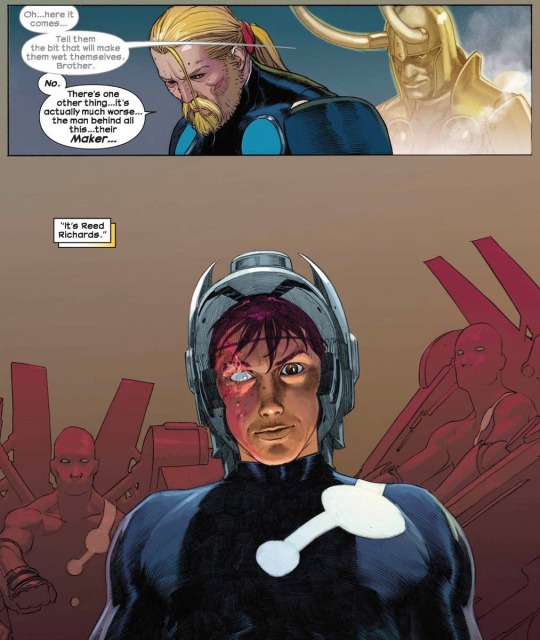
Bendis depiction of his "fall" was awful and incoherent. Under Bendis, Reed instantly becomes the type of guy willing to commit cold blooded murder against both his family and other heroes for no real reason. If Reed is pissed about the military controlling everything, why is he trying to kill Peter Parker? Shouldn't he be trying to kill Nick Fury and destroy SHIELD? That at least would make sense, Ultimate Nick Fury is a fucking awful person. Instead he murders his entire family instead of just his asshole dad because... I don't know, he's just evil now. A writer can't write someone smarter than them, and Bendis is just not the guy for tackling the world's smartest heroic mind descending into villainy. Reed's plan is dumb and paper thin.
A better approach would have been that Reed creates minions and has them attack various heroes and SHIELD, but only the attack on SHIELD is genuine. All the attacks on heroes are false flags designed to fail, Reed even has them attack himself and his home to make it look like he's a victim too. Only his dad gets killed because his dad was the one Reed hated. Reed's plan is to kill off the military handlers, and bring the heroes together to solve a threat by themselves, in hopes that everyone will see they don't need to be taking orders from SHIELD. Heroes can solve problems on their own. Reed also wants to reunite the Fantastic Four and thinks that this could remind the other three why they need each other. Of course the other heroes find out that Reed is responsible and attempt to bring him in, with Sue, Ben, and Johnny turning on him being what sends Reed off the deep end. He becomes the Maker and resolves to build a family in his image which will be what he wants them to be.
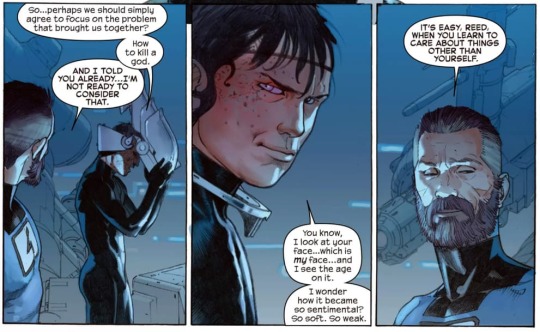
Other writers desperately tried to reconcile Ultimate Reed with how Bendis portrayed his fall but it just never worked. Hickman had the right approach, he threw Reed into the City where times passes at an accelerated rate to justify the changes. Maker isn't human anymore, not really. He's been alive for so long that his perspective on everything has changed - or so it seems. It's tough to talk about Maker in Ultimates because Hickman never got to finish his story. No doubt in my mind that the Maker storyline was meant to run for a while, but Humphries understandably didn't want to be saddled with another writer's storyline forever. My recollection is that Humphries worked off of Hickman's notes, and while the execution differed it's possible that some of what Humphries did was Hickman's intention.
Some of what Maker does under Hickman doesn't make sense if Maker is as cold and pure logic-based as he tries to come off as. For example the City is on Earth instead of the moon or whatever because the City needs a "solid foundation" which presumably means Earth like conditions. Ok - why the hell does Maker put his City in Europe? Why not Antarctica or some other remote location? In Hickman's New Avengers, Maker recreates the City in a remote region of South America, which means he had other options. Putting his City in Europe feels like he was itching for a fight. Obviously there was quite a bit of gap in time between when Hickman wrote those two issues, but then there's other odd behavior. Why does Maker insist on humiliating Thor by forcing Thor to serve as his messenger instead of just... sending a message? Why bring Falcon in and show off the City instead of kidnapping world leaders for the same effect? My belief is that Hickman does not intend for Maker to be pure logic. Spite is definitely a big part of what drives him. On some level Maker was clearly itching for revenge and for praise from his former comrades. He wanted to hurt them and impress them, or at least rub in their faces what he had achieved.
Wish Hickman would share what the original plans were, but if Humphries really was working off his notes I could totally buy that Maker was going to be brought down by a need to impress Sue. He'd bring her into the City to brag and flex on her, the jilted boyfriend simultaneously hoping to hurt her for leaving him and win her back, and she would bring him down. Unlikely that Hickman would have Reed outright admit that the way Humphries did, but as an undercurrent to his actions he may not even be aware of himself? Yeah I could buy that. As for why he doesn't care about the other Sues, he spells out in Secret Wars: they're not his Sue.
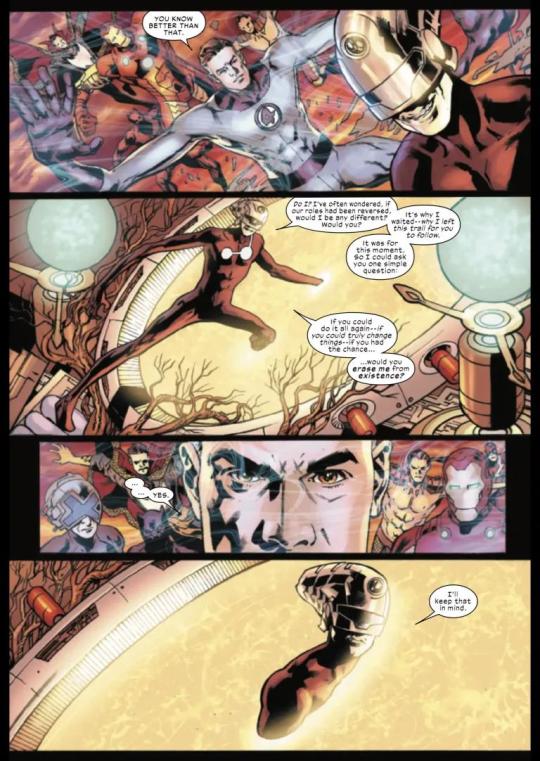
Even Hickman has him admit that he's wondered what his life would have been like if he had gotten the life 616 Reed did. Plus there's his whole torturing of 6160 Reed. He could have killed 6160 Reed along with the other three, but he didn't. Instead he turned the guy into Dr. Doom and attempted to break him. Why? What purpose does that serve? 6160 Reed knows Maker hates him but can't figure out why. My theory is that it's because Maker is trying to take a Reed who is similar to 616 Reed and transform the guy into a monster like him. It's his middle finger to 616 Reed. Maker wants to prove that 616 Reed isn't better than him, if Mr. Fantastic had lost his family and been put through hell like Maker had, he would break too. That 6160 Reed is, so far, not a monster like Maker pisses Maker off. It's not logical to keep 6160 Reed around, and doing so leads to Maker's fall.
Hope that long winded rant clarified my thoughts for you. Moving on to the second part, do we need to know the how and why of Maker to enjoy him? Depends on how he's used. Something like Cates' Venom run, no. Maker is just an Evil Reed there, we don't need his backstory to understand that he's a power hungry bastard out only for himself. Per Cates himself, Maker is there because he wanted a dark reflection of the Peter/Mr. Fantastic relationship, and it's enough that Maker is a villain working with a dark anti-hero Venom to help facilitate that. Now in Ultimate Invasion, yes you do need to understand the how and why. Problem is that it's not clear why Maker does a lot of what he does. His creation of the Ultimate Illuminati is explained and makes sense, but what is his endgame? What does he want 6160 to become? I can't tell you. No clue at all what his endgame is supposed to be. Does he want to turn the world into a global version of the City? Does he genuinely want to make a utopia? He seems content to let his underlings run their fiefdoms with a relatively free hand. 6160 America appears to be much more advanced thanks to the technocrats running things. Even allows Howard Stark and Bruce Banner to express misgivings about his rule. Public seems to think he's a great guy, presumably he didn't kill a shitload of people to build his society this time around. We needed more info on what his plans were and we didn't get them.
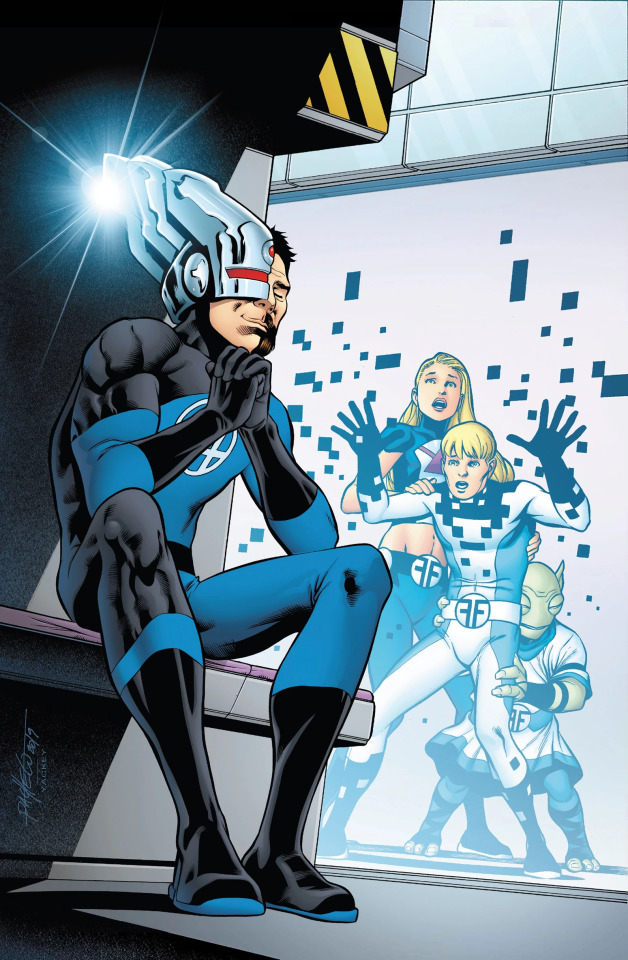
Maker is a fun character and also an inconsistent mess. One does not always preclude the other. Now my personal opinion is that he's approaching the end of his lifespan, I think Hickman needs to give him an ending. Whether that's death or something else I don't know, but a confrontation between Maker, Mr. Fantastic, and DoomReed is all that's left to do with him I feel. Hickman is really the only one who has used him to his full potential anyway. Give him a proper send-off to close the door on the old Ultimate Universe as we move into the new one.
39 notes
·
View notes
Text
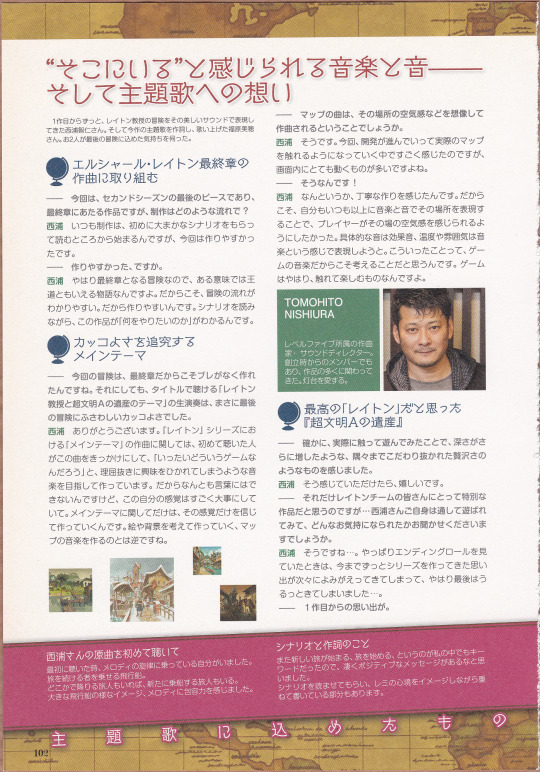
Azran Legacy Guidebook: Page 102
Previous Page: Page 101
Experience the feelings behind the main theme.
Ever since the first game, Tomohito Nishiura-san has been creating the beautiful soundtrack of Professor Layton’s adventures. And for this game, the main theme was written and sung by Miho Fukuhara-san. We asked them both about how they feel about the final result.
TOMOHITO NISHIURA
A composer working for Level-5 and director of the sound team. Has been a member since the beginning and has worked on many projects. Loves lighthouses.
Working on composing for Hershel Layton’s final chapter
As the the final part of this second trilogy, what was the work flow like?
Nishiura As always, we started by reading the rough scenes but the process was easy this time.
It was easy to make?
It was the final part of the adventure, which in a way, made thing easier. It was easy to understand the direction of the story, which is why I say it was easier. While reading the script, I was thinking, “what do I want to make (of this)?”
“A cool main theme”
As the last chapter, the adventure was able to be made without any major changes. The live performance of the theme for “Professor Layton and the Azran Legacy” that plays in the title was fitting for the final adventure, it was very cool.
Nishiura Thank you. When composing “Layton” series ‘main themes’, I want to make music that people will say “what on earth is this game”, upon hearing it for the first time, and make them curious. That’s why, I don’t know how to say it, but the (piece’s) feeling of identity is important. The main theme must be made with that feeling. It’s the opposite of composing, say, a map theme, where you have art or scenery to think of.
So you compose map themes by imagining the location’s atmosphere?
Nishiura That’s right. This time, during development I was able to tap on the actual map and saw there were a lot of moving objects on the screen.
There is, right?
Nishiura How do I put it? It feels like it was made very thoroughly. I wanted to go above and beyond with the music and sound of the locations, so that the player could to feel the atmosphere of the location. We used specific sounds and sound effects to express such as temperature and atmosphere. I think game music helps us think about these sorts of things. Of course, the game was also enjoyable to tap around on.
I thought “Azran Legacy” was the best “Layton”
For certain, having played it, there is even more depth depth, it feels like every aspect seems to have been carefully considered.
Nishiura I’m glad you feel that way.
Everyone in the Layton Team think this work was special… Nishiura-san, when you played it yourself, how did you feel?
Nishiura That’s right… When I saw the credits, I remembered all of the series up until now, one by one, and I found that really moving.
(the interview continues on next page)
-
First time listening to Nishiura-san’s original piece The first time I heard it, I put myself in the sound of the melody. Like I was travelling in an airship. Some travellers were leaving, and new ones were arriving. I imagined the image of a big airship, as the melody played.
Scenario and lyrics The key words for the song were “a new journey is beginning” and “setting out on a journey”, a very positive message, I think. I read the script, and then also wrote parts which included imagery relating to Emmy’s state of mind.
シナリオ と作詞のこと また新しい旅が始まる、旅を始める、というのが私の中でもキーワードだったので、凄くボジテイプなメッセージかあるなと思いました。 シナリオを読ませてもらい、レミの心境をイメージしながら重ねて書いている部分もあります。
"そこいると" 感じれ音楽 と 音そそして主題歌への想い
1 作目からすっと、レイトン教授の冒険をその美しいサウンドで表現してきた西浦智仁さん。そして今作の主題歌を作詞し、歌い上げた福原美穂さん。お 2 人が最後の冒険に込めた気持ちを伺った。
TOMOHITO NISHIURA レベルファイプ所属の作曲家・サウンドディレクタ ー創立時からのメンバ ー でもあり、作品の多くに関わってきた。灯台を愛する。
工ルシャ ー ル・レイトン最終章の作曲に取い組む
今回は、セカンドシーズンの最後のピ ー スであり、最終章にあたる作品ですが、制作はとのような流れで?
西浦 いつも制作は、初めに大まかなシナリオをもらって読むところから始まるんですが、今回は作りやすかったです。
作りやすかった、ですか。
西浦 やはり最終章となる冒険なので、ある意味では王道ともいえる物語なんですよ。だからこそ、冒険の流れがわかりやすい。だから作りやすいんです。シナリオを読みながら、この作品が「何をやりたいのか」がわかるんです。
カッコよマ追究すメインテ ー マ
今回の冒険は、最終章たからこそブレがなく作れたんですね。それにしても、タイトルで聴ける「レイトン教授と超文明 A の遺産のテ ー マ」の生演奏は、まさに最後の冒険にふさわしいカッコよさでした。
西浦 ありがとうこさいます。「レイトン」シリ ー ズにおける「メインテ ー マ」の作曲に関しては、初めて聴いた人がこの曲をきっかけにして、「いったいどういうゲ ー ムなんだろう」と、理屈抜きに興味をひかれてしまうような音楽を目指して作っています。だからなんとも言葉にはできないんですけど、この自分の感覚はすこく大事にしていて。メインテーマに関してだけは、その感覚だけを信じて作っていくんです。絵や背景を考えて作っていく、マップの音楽を作るのとは逆ですね。
マップの曲は、その場所の空気感なとを想像して曲されるということでしようか。
西浦 そうです。今回、開発が進んでいって実際のマップを触れるようになっていく中ですこく感じたのですが、画面内にとても動くものが多いですよね。
そうなんです!
西浦 なんというか、丁寧な作りを感じたんです。だからこそ、自分もいつも以上に音楽と音でその場所を表現することで、プレイヤ ー がその場の空気感を感じられるようにしたかった。具体的な音は効果音、温度や雰囲気は音楽という感じで表現しようと。こういったことって、ゲ ームの音楽だからこそ考えることだと思うんです。ゲ ー ムはやはり、触れて楽しむものなんですよ。
最高の「レイトン」だと思った『超文明 A の造産』
確かに、実際に触って遊んでみたことで、深さかさらに増したような、隅々までこだわり抜かれた贅沢さのようなものを感しました。
西浦 そう感じていただけたら、嬉しいです。
それだけレイトンチ ー ムの皆さんにとって特別な作品だと思うのですか・・・西浦さん自身は通して遊ばれてみて、どんなお気持になられたかお聞かせくたさいますでしようか。
西浦 そうですね・・・。やつぱりエンディングロールを見ていたときは、今までずっとシリーズを作ってきた思い出が次々によみがえってきてしまって、やはり最後はうるっときてしまいました
西浦さんの原曲初めて聽いて 最初に聴いた時、メロディの旋律に乗っている自分がいました。 旅を続ける者を乗せる飛行船。 とこかで降りる旅人もいれは、新たに乗船する旅人もいる。 大きな飛行船の様なイメ ー ジ、メロディに包容力を感じました。
10 notes
·
View notes